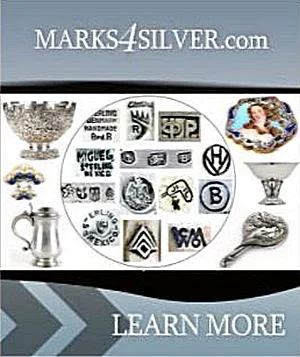Pricing Guides & Dictionary of Makers Marks for Antiques & Collectibles

A few examples of appraisal values for
RESULTS
Search our price guide for your own treasures
-
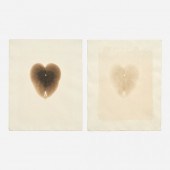 JOHN GUTOWSKI PAIR OF UNTITLED
JOHN GUTOWSKI PAIR OF UNTITLED KALLITYPES (1994)John W. Gutowski (American, 1948-2001) Untitled, 1994 Two kallitypes 14 1/2" x 11 3/4" (each sheet), 22 1/4" x 18 1/4" (each frame) Each is signed and dated to the reverse. In John W. Gutowski: Photographic Suites 1979-2001 , curator Elisabeth Kirsch offered context on Gutowski's use of this rare medium: "John was the only artist in the country I could find who still made kallitypes, a difficult technique that results in deep umber tones of delicate beauty. He never lost his love of the alchemical magic required to create a photograph." Condition Good condition, noting soft handling creases to the sheet of the darker image and gentle rippling to each sheet. Slight wear to one frame.
JOHN GUTOWSKI PAIR OF UNTITLED
JOHN GUTOWSKI PAIR OF UNTITLED KALLITYPES (1994)John W. Gutowski (American, 1948-2001) Untitled, 1994 Two kallitypes 14 1/2" x 11 3/4" (each sheet), 22 1/4" x 18 1/4" (each frame) Each is signed and dated to the reverse. In John W. Gutowski: Photographic Suites 1979-2001 , curator Elisabeth Kirsch offered context on Gutowski's use of this rare medium: "John was the only artist in the country I could find who still made kallitypes, a difficult technique that results in deep umber tones of delicate beauty. He never lost his love of the alchemical magic required to create a photograph." Condition Good condition, noting soft handling creases to the sheet of the darker image and gentle rippling to each sheet. Slight wear to one frame. -
 2VOL A. STEPHENS, WAR BETWEEN THE
2VOL A. STEPHENS, WAR BETWEEN THE STATES 1ST ED. A Constitutional View of the Late War Between the States; It's Causes, Character, Conduct, and Results. Presented in a Series of Colloquies at Liberty Hall by Alexander H. Stephens. Published 1868 by National Publishing Company. First edition. Books are bound in the original publisher's leather with a stamped logo of the publishing company. Burgundy leather boards with gilt titling on the spine. 4to.
2VOL A. STEPHENS, WAR BETWEEN THE
2VOL A. STEPHENS, WAR BETWEEN THE STATES 1ST ED. A Constitutional View of the Late War Between the States; It's Causes, Character, Conduct, and Results. Presented in a Series of Colloquies at Liberty Hall by Alexander H. Stephens. Published 1868 by National Publishing Company. First edition. Books are bound in the original publisher's leather with a stamped logo of the publishing company. Burgundy leather boards with gilt titling on the spine. 4to. -
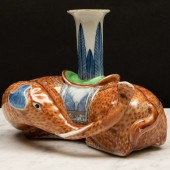 CHINESE EXPORT IRON RED PORCELAIN
CHINESE EXPORT IRON RED PORCELAIN RECLINING ELEPHANT FORM CANDLESTICKUnmarked. 5 1/4 x 8 x 5 in. Condition Minor wear and losses to the decoration. A small area of restoration to the mid section of the trunk. Otherwise in good condition. TL test holes to the base, results unavailable.Not withstanding this report or any discussion concerning condition of a lot, all lots are offered and sold "as is" in accordance with our conditions of sale.
CHINESE EXPORT IRON RED PORCELAIN
CHINESE EXPORT IRON RED PORCELAIN RECLINING ELEPHANT FORM CANDLESTICKUnmarked. 5 1/4 x 8 x 5 in. Condition Minor wear and losses to the decoration. A small area of restoration to the mid section of the trunk. Otherwise in good condition. TL test holes to the base, results unavailable.Not withstanding this report or any discussion concerning condition of a lot, all lots are offered and sold "as is" in accordance with our conditions of sale. -
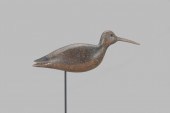 THE HARMON RUNNING COBB
THE HARMON RUNNING COBB CURLEWNathan F. Cobb Jr. (1825-1905) Cobb Island, VA, c. 1880 15 1/2 in. long “Every Nathan Cobb decoy had its own natural pose. Even his Hudsonian Curlews…seemed to run, feed, and walk." — William J. Mackey Jr., discussing a Cobb curlew in "American Bird Decoys," plate VII “An original box of goose eyes found in Nathan’s shed shows that he sent to Germany for them and obtained the finest.” — William J. Mackey Jr., "American Bird Decoys" Nathan Cobb Sr. sailed his family south from Eastham on Cape Cod to the Eastern Shore of Virginia where they began to settle around 1837. The family brought with them their native Massachusetts decoy concepts, including German bead-glass eyes and the refined split-tail carving style adopted by Lothrop Holmes, A. Elmer Crowell, and Joseph Lincoln. Over time, the Cobbs evolved this style into one of their own with robust elements and their signature ridged backs. A dynamic, yet well-balanced decoy, this curlew exhibits pleasing proportions. The reaching and gracefully rounded head is cocked ever so slightly to the right with an inquisitive gaze and is finished with full cheeks topped by deep eye grooves and German bead-glass eyes. Under the thin neck, the grand body resolves with a precise Cobb Island tail cut. This confident carving, featuring the Cobb’s laconic feathering, represents the pinnacle of the Southern standard. This curlew, with its original paint, crisp clean lines, and original bill, is among the very finest shorebirds that survived the remote island’s storm-wrecked history. Cobb curlews in any pose are highly sought after, and the running models have been among the most coveted decoys of all time. Indeed, on three occasions they have posted auction results over $200,000, more showings than any other maker’s curlew. The closest known comparable to this lot was acquired by Dr. Lloyd T. Griffith at auction in 2006 for $390,000, a record for any Southern decoy at the time. This lot is surfacing for the first time in the modern collecting era after residing quietly in private collections, including most recently the distinguished collection of Ted and Judy Harmon, who are heralded for collecting some of the finest Massachusetts shorebird decoys. Excellent original paint with even gunning wear. Original bill has minute traces of black overpaint. Provenance: Ted and Judy Harmon Collection Literature: Dr. S. Lloyd Newberry, "Wings of Wonder: The Remarkable Story of the Cobb Family and the Priceless Decoys They Created on Their Island Paradise," Columbia, SC, 2020, p. 166, initials discussed, p. 168, closely related record-setting decoy illustrated, pp. 248-249, related curlew illustrated. William J. Mackey Jr., "American Bird Decoys," New York, NY, 1965, color pl. VII, curlew with plover bill illustrated. Robert Shaw, "Bird Decoys of North America," New York, NY, 2010, p. 214, McCleery’s Cobb curlew illustrated. Henry A. Fleckenstein Jr., "Southern Decoys of Virginia and The Carolinas," Exton, PA, 1983, pp. 206-211, Cobb curlews illustrated. Kory W. Rogers, “Birds of a Feather,” Shelburne, VT, 2017, p. 130, related examples illustrated.
THE HARMON RUNNING COBB
THE HARMON RUNNING COBB CURLEWNathan F. Cobb Jr. (1825-1905) Cobb Island, VA, c. 1880 15 1/2 in. long “Every Nathan Cobb decoy had its own natural pose. Even his Hudsonian Curlews…seemed to run, feed, and walk." — William J. Mackey Jr., discussing a Cobb curlew in "American Bird Decoys," plate VII “An original box of goose eyes found in Nathan’s shed shows that he sent to Germany for them and obtained the finest.” — William J. Mackey Jr., "American Bird Decoys" Nathan Cobb Sr. sailed his family south from Eastham on Cape Cod to the Eastern Shore of Virginia where they began to settle around 1837. The family brought with them their native Massachusetts decoy concepts, including German bead-glass eyes and the refined split-tail carving style adopted by Lothrop Holmes, A. Elmer Crowell, and Joseph Lincoln. Over time, the Cobbs evolved this style into one of their own with robust elements and their signature ridged backs. A dynamic, yet well-balanced decoy, this curlew exhibits pleasing proportions. The reaching and gracefully rounded head is cocked ever so slightly to the right with an inquisitive gaze and is finished with full cheeks topped by deep eye grooves and German bead-glass eyes. Under the thin neck, the grand body resolves with a precise Cobb Island tail cut. This confident carving, featuring the Cobb’s laconic feathering, represents the pinnacle of the Southern standard. This curlew, with its original paint, crisp clean lines, and original bill, is among the very finest shorebirds that survived the remote island’s storm-wrecked history. Cobb curlews in any pose are highly sought after, and the running models have been among the most coveted decoys of all time. Indeed, on three occasions they have posted auction results over $200,000, more showings than any other maker’s curlew. The closest known comparable to this lot was acquired by Dr. Lloyd T. Griffith at auction in 2006 for $390,000, a record for any Southern decoy at the time. This lot is surfacing for the first time in the modern collecting era after residing quietly in private collections, including most recently the distinguished collection of Ted and Judy Harmon, who are heralded for collecting some of the finest Massachusetts shorebird decoys. Excellent original paint with even gunning wear. Original bill has minute traces of black overpaint. Provenance: Ted and Judy Harmon Collection Literature: Dr. S. Lloyd Newberry, "Wings of Wonder: The Remarkable Story of the Cobb Family and the Priceless Decoys They Created on Their Island Paradise," Columbia, SC, 2020, p. 166, initials discussed, p. 168, closely related record-setting decoy illustrated, pp. 248-249, related curlew illustrated. William J. Mackey Jr., "American Bird Decoys," New York, NY, 1965, color pl. VII, curlew with plover bill illustrated. Robert Shaw, "Bird Decoys of North America," New York, NY, 2010, p. 214, McCleery’s Cobb curlew illustrated. Henry A. Fleckenstein Jr., "Southern Decoys of Virginia and The Carolinas," Exton, PA, 1983, pp. 206-211, Cobb curlews illustrated. Kory W. Rogers, “Birds of a Feather,” Shelburne, VT, 2017, p. 130, related examples illustrated. -
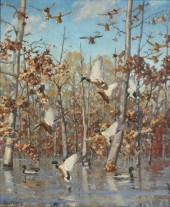 RICHARD E. BISHOP
RICHARD E. BISHOP (1887-1975)Prairie Wings, 1945 signed and dated "Richard E Bishop '45 ©" lower left oil on canvas, 30 by 25 in. signed, titled, and dated on back An edition of "Prairie Wings" by Edgar M. Queeny, published by Ducks Unlimited in 1946 accompanies the lot. In 1946, Edgar Queeny published "Prairie Wings" through Ducks Unlimited. It is now one of the most important books on waterfowl ever written. He studied the landing patterns of birds over Wingmead, his 14,000 acre property in Arkansas, which had three named green tree reservoirs: Wingmead, Paddlefoot, and Greenwood. Queeny was an active patron of Bishop's and partnered with the artist for the many illustrations throughout the book, including the color frontispiece. Queeny wrote, “Dick’s paintings and etchings of wildfowl are outstanding because he is not only a superb artist but a topnotch engineer! As a result of his engineering training and his understanding of aerodynamics, mechanics of flight and the anatomy of birds came as second nature to him…the results are portraits of birds as they really fly!” Bishop’s original drawings and Queeny’s photographs from "Prairie Wings" were donated by Thomas K. Figge to the John L. Wehle Gallery of Sporting Art at the Genesee Country Village & Museum in 1986, where they remain in the permanent collection. This famous frontispiece for "Prairie Wings" comes from the collection of Joseph N. Pew Jr., the Sun Oil heir, philanthropist, and avid sportsman. He hunted and fished in Nova Scotia, started the Pew Charitable Trusts, and likely encountered Edgar M. Queeny in New York’s Links Club, where both were members. Provenance: Joseph N. Pew Jr. Collection Alberta Hensel Pew Baker Collection, Chester, Nova Scotia Private Collection Literature: Edgar M. Queeny, "Prairie Wings: Pen and Camera Flight Studies," New York, NY, 1946, frontispiece, XIII, p. 225.
RICHARD E. BISHOP
RICHARD E. BISHOP (1887-1975)Prairie Wings, 1945 signed and dated "Richard E Bishop '45 ©" lower left oil on canvas, 30 by 25 in. signed, titled, and dated on back An edition of "Prairie Wings" by Edgar M. Queeny, published by Ducks Unlimited in 1946 accompanies the lot. In 1946, Edgar Queeny published "Prairie Wings" through Ducks Unlimited. It is now one of the most important books on waterfowl ever written. He studied the landing patterns of birds over Wingmead, his 14,000 acre property in Arkansas, which had three named green tree reservoirs: Wingmead, Paddlefoot, and Greenwood. Queeny was an active patron of Bishop's and partnered with the artist for the many illustrations throughout the book, including the color frontispiece. Queeny wrote, “Dick’s paintings and etchings of wildfowl are outstanding because he is not only a superb artist but a topnotch engineer! As a result of his engineering training and his understanding of aerodynamics, mechanics of flight and the anatomy of birds came as second nature to him…the results are portraits of birds as they really fly!” Bishop’s original drawings and Queeny’s photographs from "Prairie Wings" were donated by Thomas K. Figge to the John L. Wehle Gallery of Sporting Art at the Genesee Country Village & Museum in 1986, where they remain in the permanent collection. This famous frontispiece for "Prairie Wings" comes from the collection of Joseph N. Pew Jr., the Sun Oil heir, philanthropist, and avid sportsman. He hunted and fished in Nova Scotia, started the Pew Charitable Trusts, and likely encountered Edgar M. Queeny in New York’s Links Club, where both were members. Provenance: Joseph N. Pew Jr. Collection Alberta Hensel Pew Baker Collection, Chester, Nova Scotia Private Collection Literature: Edgar M. Queeny, "Prairie Wings: Pen and Camera Flight Studies," New York, NY, 1946, frontispiece, XIII, p. 225. -
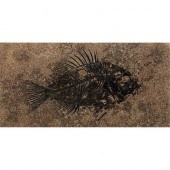 GREEN RIVER FOSSILIZED EOCENE
GREEN RIVER FOSSILIZED EOCENE FISH IN HONED FINISHED TI...Features a right-facing Priscacara serrata fish. The Priscacara are found in the Green River Formation in Wyoming. They had rounded, crushing teeth. The honed method is used which results in a smooth matte stone finish where the fossil is displayed in cross section flush with the surface of the stone. Issued: Eocene Dimensions: 4"H x 8"W Manufacturer: Green River Stone Co. Country of Origin: United States Condition: Overall good
GREEN RIVER FOSSILIZED EOCENE
GREEN RIVER FOSSILIZED EOCENE FISH IN HONED FINISHED TI...Features a right-facing Priscacara serrata fish. The Priscacara are found in the Green River Formation in Wyoming. They had rounded, crushing teeth. The honed method is used which results in a smooth matte stone finish where the fossil is displayed in cross section flush with the surface of the stone. Issued: Eocene Dimensions: 4"H x 8"W Manufacturer: Green River Stone Co. Country of Origin: United States Condition: Overall good -
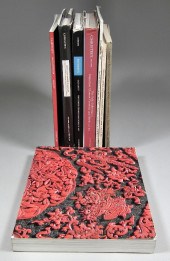 A collection of three hundred and
A collection of three hundred and fifty eight Sotheby\'s Christies and other UK auction catalogues of Oriental Works of Art interest dating from the 1960\'s to the present day various (the majority retaining sale results lists)
A collection of three hundred and
A collection of three hundred and fifty eight Sotheby\'s Christies and other UK auction catalogues of Oriental Works of Art interest dating from the 1960\'s to the present day various (the majority retaining sale results lists) -
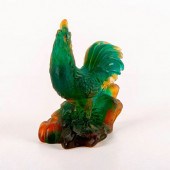 DAUM FROSTED CRYSTAL ROOSTER, AMBER
DAUM FROSTED CRYSTAL ROOSTER, AMBER GREEN 02693Handmade crystal rooster in bold green and amber coloration. This rare and ancient glassmaking technique, which dates back to 5,000 B.C., involves melting many fragments of colored crystal within a mold. This results in intense colors and subtle shading. Daum France signed on the bottom. #daum #crystal #rooster Issued: 20th c. Dimensions: 4"H Manufacturer: Daum Country of Origin: France Condition: Good.
DAUM FROSTED CRYSTAL ROOSTER, AMBER
DAUM FROSTED CRYSTAL ROOSTER, AMBER GREEN 02693Handmade crystal rooster in bold green and amber coloration. This rare and ancient glassmaking technique, which dates back to 5,000 B.C., involves melting many fragments of colored crystal within a mold. This results in intense colors and subtle shading. Daum France signed on the bottom. #daum #crystal #rooster Issued: 20th c. Dimensions: 4"H Manufacturer: Daum Country of Origin: France Condition: Good. -
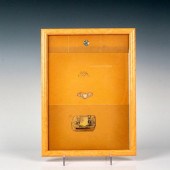 RENE LALIQUE (FRENCH, 1860-1945)
RENE LALIQUE (FRENCH, 1860-1945) ORIGINAL DRAWING, FLOR...These splendid jewelry studies in graphite, India ink, and gouache on BFK Rives brown paper were made by Art Nouveau and Art Deco designer and craftsman Rene Lalique. Three sheets of individual drawings have been combined in a single frame to form a series of four designs for rings and a choker brooch with an opal. The upper floral design is in a finished state with highlights of opaque white reflecting on the petals and stems that Lalique set on a dark brown background. The central drawings include a graphite drawing of flowers in bloom while Lalique refined the design of the ring where he set a large triangular opal surrounded with brilliant flowers. Lalique added shadows under the choker brooch set with the large opal that results in an imposing jewelry design. These miniature artworks are of museum quality and were acquired directly from the private collection of the descendants of Rene Lalique. Housed in a natural color wooden frame. Frame size: 9.80"L x 13.40"H x 0.75"W. Artworks dimensions: upper sheet 8.55"L x 1.80"H; center sheet:8.50"L x 5.50"H; lower sheet: 8.50"L x 4.80"H. Artist: Rene Jules Lalique (French, 1860-1945) Issued: c. 1895 Country of Origin: France Provenance: Collection of Marie-Claude Lalique Condition: Age related wear.
RENE LALIQUE (FRENCH, 1860-1945)
RENE LALIQUE (FRENCH, 1860-1945) ORIGINAL DRAWING, FLOR...These splendid jewelry studies in graphite, India ink, and gouache on BFK Rives brown paper were made by Art Nouveau and Art Deco designer and craftsman Rene Lalique. Three sheets of individual drawings have been combined in a single frame to form a series of four designs for rings and a choker brooch with an opal. The upper floral design is in a finished state with highlights of opaque white reflecting on the petals and stems that Lalique set on a dark brown background. The central drawings include a graphite drawing of flowers in bloom while Lalique refined the design of the ring where he set a large triangular opal surrounded with brilliant flowers. Lalique added shadows under the choker brooch set with the large opal that results in an imposing jewelry design. These miniature artworks are of museum quality and were acquired directly from the private collection of the descendants of Rene Lalique. Housed in a natural color wooden frame. Frame size: 9.80"L x 13.40"H x 0.75"W. Artworks dimensions: upper sheet 8.55"L x 1.80"H; center sheet:8.50"L x 5.50"H; lower sheet: 8.50"L x 4.80"H. Artist: Rene Jules Lalique (French, 1860-1945) Issued: c. 1895 Country of Origin: France Provenance: Collection of Marie-Claude Lalique Condition: Age related wear. -
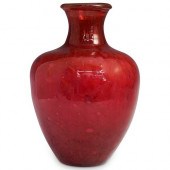 STEUBEN RED CLUTHRA GLASS
STEUBEN RED CLUTHRA GLASS VASEDESCRIPTION: Steuben red Cluthra glass vase. Cased lead glass. Reference: Shape 8494, p. 302 Paul V. Gardner. Pictured p. 66 of Objects of Desire: The Art of Frederick Carder by Alan Shovers. Special order piece. Inside is pink cluthra. Casing is perhaps antique green. Top lip shows the green coloration that results. Provenance: Estate of Mr. and Ms. Alan Shovers Acquired from dealer Joan Miller of Chicago, IL at O, Hare Antique Show. CIRCA: Early 1900s DIMENSIONS: H: 13" x D: 9" CONDITION: Great condition. Normal signs of age. See lot description for details on item condition. More detailed condition requests can be obtained via email (info@akibaantiques.com) or SMS 305-332-9274. Any condition statement given, as a courtesy to a client, is only an opinion and should not be treated as a statement of fact. Akiba Antiques shall have no responsibility for any error or omission.
STEUBEN RED CLUTHRA GLASS
STEUBEN RED CLUTHRA GLASS VASEDESCRIPTION: Steuben red Cluthra glass vase. Cased lead glass. Reference: Shape 8494, p. 302 Paul V. Gardner. Pictured p. 66 of Objects of Desire: The Art of Frederick Carder by Alan Shovers. Special order piece. Inside is pink cluthra. Casing is perhaps antique green. Top lip shows the green coloration that results. Provenance: Estate of Mr. and Ms. Alan Shovers Acquired from dealer Joan Miller of Chicago, IL at O, Hare Antique Show. CIRCA: Early 1900s DIMENSIONS: H: 13" x D: 9" CONDITION: Great condition. Normal signs of age. See lot description for details on item condition. More detailed condition requests can be obtained via email (info@akibaantiques.com) or SMS 305-332-9274. Any condition statement given, as a courtesy to a client, is only an opinion and should not be treated as a statement of fact. Akiba Antiques shall have no responsibility for any error or omission. -
 SIGNED & DATED TN POWDER HORNSigned
SIGNED & DATED TN POWDER HORNSigned and dated early 19th century Jonesborough, Tennessee powder horn, incised on the body "1827, Samuel Aken, His Horn, Jonesborough Tennessee" with additional fylfot design. Retains the original wood plug. 12 1/4" outer circumference of longest curve. Initial genealogical searches for this name in Tennessee census records did not yield conclusive results. (Higher-resolution photos are available at www.caseantiques.com) Condition: Hole on side near plug end. Otherwise overall very good condition.
SIGNED & DATED TN POWDER HORNSigned
SIGNED & DATED TN POWDER HORNSigned and dated early 19th century Jonesborough, Tennessee powder horn, incised on the body "1827, Samuel Aken, His Horn, Jonesborough Tennessee" with additional fylfot design. Retains the original wood plug. 12 1/4" outer circumference of longest curve. Initial genealogical searches for this name in Tennessee census records did not yield conclusive results. (Higher-resolution photos are available at www.caseantiques.com) Condition: Hole on side near plug end. Otherwise overall very good condition. -
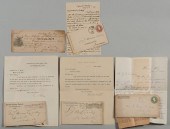 CSA GENLS. LETTERS TO J. B.
CSA GENLS. LETTERS TO J. B. LINDSLEY: STEWART, WHEELER,...Archive of 5 Letters and Documents with signatures / autographs of Confederate Generals Alexander P. Stewart, Joseph Wheeler, and William Bate (all post-war), related to John Berrien Lindsley, prominent Nashville Tennessee author and educator. 1st item: Autographed letter, signed, former Confederate General Alexander Peter Stewart to Lindsley on lined paper, dated Aug. 24, 1886, Oxford Mississippi (Stewart, born in Rogersville, Tenn., went on to serve as Chancellor of the University of Mississippi). Stewart writes "Send the book here, unless I notify you to contrary before it is ready. Cowper wrote 'but War's a game which, were their subjects wise, kings would not play at.' In imitation, the first sentence of my paper is 'War is a fearful game for kings or peoples to play at'. It needs the preposition at the end. In this country it is not kings but the people who 'play at' war. I trust the finanical results will fully meet your expectations. I do not know where I shall go, yet, now how employ myself. Think I have served my time in schools." (Stewart fought in all the major battles of the Army of Tennessee: Shiloh, Perryville, Stones River, Chickamauga, Chattanooga, the Atlanta Campaign, Franklin, Nashville, and the Carolina Campaign. Stewart left the University of Mississippi in 1886; that same year, Lindsley's book, "The Military Annals of Tennessee," was published). One sheet, front and back. 2nd item: ALS, former Confederate General Joseph Wheeler to John Berrien Lindsley on lined and embossed paper, dated June 11, 1884, Wheeler, Alabama, regarding Lindsley's request for "a condensed statement of the table of battle, or skirmishes" related to his upcoming book. Wheeler asks for clarification and agrees to "furnish you the rosters of several regiments." There is also mention of the cost of large vs. small engravings and a small newpaper clipping about Wheeler. Two pages. 3rd item: Document signed, former Confederate General Joseph Wheeler to General William Bate, dated October 14, 1898, "Dear General, It will give me great pleasure to do anything requested by you and I have a high appreciation for the Lindsley family. Since you wrote the letter I have been relieved from duty at Montauk Point and am now on duty at Huntsville. Anything I can consistently do for Mr. Lindsley will be gladly done." Typewritten with hand signature. En verso is a handwritten note, signed by Bate, "Dear Mrs. Lindsley, I here send you the reply of Gen. Wheeler to my letter sent to him at your request. Very resp. Wm. B. Bate." 4th item: DS, former Confederate General William Bate, to John Berrien Lindsley, on United States Senate letterhead, dated March 2, 1896. Typewritten with ink signature, regarding forthcoming publication of the book Presidential Messages and a promise to have it sent to Lindsley when issued. 5th item: 1885 Promissory note signed by both John Berrien Lindsley and Gen. William Bate. The note is also signed by J. Mac Lindsley, promising to repay Bate $100 with interest, two months after Aug. 18, 1885, at First National Bank, John Berrien Lindsley as co-signer. Vignette of stag at left. Bate's signature also appears on back. 3 1/2" x 8". Provenance: formerly from the collection of Miss Margaret Lindsley Warden of Nashville, Tennessee. (Higher-resolution photos are available at www.caseantiques.com) Condition: 1st item: Stewart letter has spotty fading, including on his signature. Retains envelope. 2nd item: Wheeler clipping has left two spots of acid burn, each 4 1/2" x 2" on page 1. Wheeler's signature is in very good condition. Retains U.S. Senate envelope (separations at fold lines on envelope). 3rd item: Fold across Wheeler's signature. Bate's signature very good. Retains U.S. Senate envelope, intact. 4th item: Very good condition but with fold line across Bate's signature, retains envelope. 5th item: Toning to promissary note, darker at edges, and edge losses.
CSA GENLS. LETTERS TO J. B.
CSA GENLS. LETTERS TO J. B. LINDSLEY: STEWART, WHEELER,...Archive of 5 Letters and Documents with signatures / autographs of Confederate Generals Alexander P. Stewart, Joseph Wheeler, and William Bate (all post-war), related to John Berrien Lindsley, prominent Nashville Tennessee author and educator. 1st item: Autographed letter, signed, former Confederate General Alexander Peter Stewart to Lindsley on lined paper, dated Aug. 24, 1886, Oxford Mississippi (Stewart, born in Rogersville, Tenn., went on to serve as Chancellor of the University of Mississippi). Stewart writes "Send the book here, unless I notify you to contrary before it is ready. Cowper wrote 'but War's a game which, were their subjects wise, kings would not play at.' In imitation, the first sentence of my paper is 'War is a fearful game for kings or peoples to play at'. It needs the preposition at the end. In this country it is not kings but the people who 'play at' war. I trust the finanical results will fully meet your expectations. I do not know where I shall go, yet, now how employ myself. Think I have served my time in schools." (Stewart fought in all the major battles of the Army of Tennessee: Shiloh, Perryville, Stones River, Chickamauga, Chattanooga, the Atlanta Campaign, Franklin, Nashville, and the Carolina Campaign. Stewart left the University of Mississippi in 1886; that same year, Lindsley's book, "The Military Annals of Tennessee," was published). One sheet, front and back. 2nd item: ALS, former Confederate General Joseph Wheeler to John Berrien Lindsley on lined and embossed paper, dated June 11, 1884, Wheeler, Alabama, regarding Lindsley's request for "a condensed statement of the table of battle, or skirmishes" related to his upcoming book. Wheeler asks for clarification and agrees to "furnish you the rosters of several regiments." There is also mention of the cost of large vs. small engravings and a small newpaper clipping about Wheeler. Two pages. 3rd item: Document signed, former Confederate General Joseph Wheeler to General William Bate, dated October 14, 1898, "Dear General, It will give me great pleasure to do anything requested by you and I have a high appreciation for the Lindsley family. Since you wrote the letter I have been relieved from duty at Montauk Point and am now on duty at Huntsville. Anything I can consistently do for Mr. Lindsley will be gladly done." Typewritten with hand signature. En verso is a handwritten note, signed by Bate, "Dear Mrs. Lindsley, I here send you the reply of Gen. Wheeler to my letter sent to him at your request. Very resp. Wm. B. Bate." 4th item: DS, former Confederate General William Bate, to John Berrien Lindsley, on United States Senate letterhead, dated March 2, 1896. Typewritten with ink signature, regarding forthcoming publication of the book Presidential Messages and a promise to have it sent to Lindsley when issued. 5th item: 1885 Promissory note signed by both John Berrien Lindsley and Gen. William Bate. The note is also signed by J. Mac Lindsley, promising to repay Bate $100 with interest, two months after Aug. 18, 1885, at First National Bank, John Berrien Lindsley as co-signer. Vignette of stag at left. Bate's signature also appears on back. 3 1/2" x 8". Provenance: formerly from the collection of Miss Margaret Lindsley Warden of Nashville, Tennessee. (Higher-resolution photos are available at www.caseantiques.com) Condition: 1st item: Stewart letter has spotty fading, including on his signature. Retains envelope. 2nd item: Wheeler clipping has left two spots of acid burn, each 4 1/2" x 2" on page 1. Wheeler's signature is in very good condition. Retains U.S. Senate envelope (separations at fold lines on envelope). 3rd item: Fold across Wheeler's signature. Bate's signature very good. Retains U.S. Senate envelope, intact. 4th item: Very good condition but with fold line across Bate's signature, retains envelope. 5th item: Toning to promissary note, darker at edges, and edge losses. -
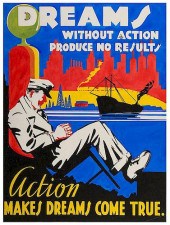 DREAMS WITHOUT ACTION PRODUCE NO
DREAMS WITHOUT ACTION PRODUCE NO RESULTS. ACTION MAKES ...Anonymous. Dreams Without Action Produce No Results. Action Makes Dreams Come True. Circa 1930s. Acrylic and pencil on board. 15 x 20 inches. Original WPA-era work-incentive poster artwork depicts a man in uniform idling, while the industrial world powers ahead in the background. Lightly scuffed with some correctional pencil markings.
DREAMS WITHOUT ACTION PRODUCE NO
DREAMS WITHOUT ACTION PRODUCE NO RESULTS. ACTION MAKES ...Anonymous. Dreams Without Action Produce No Results. Action Makes Dreams Come True. Circa 1930s. Acrylic and pencil on board. 15 x 20 inches. Original WPA-era work-incentive poster artwork depicts a man in uniform idling, while the industrial world powers ahead in the background. Lightly scuffed with some correctional pencil markings. -
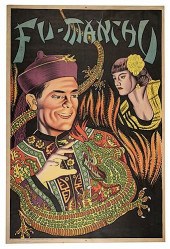 FU MANCHU (DAVID BAMBERG).
FU MANCHU (DAVID BAMBERG). FU-MANCHU.Ca. 1940. Full color lithograph poster bears a striking portrait of the magician in costume with his hands outstretched, his portrait encircled by a snarling dragon as a woman looks on. Inscription in bottom corner reads: “To Edwin J Fechter, Buenos Aires, Argentina Feb. 23, 1950. Obtained from “Fu-Manchu” Compliments of H.A. Morlock.” 29 x 43 ¼". Minor repairs; A. The last of the Bamberg dynasty of magicians, Fu Manchu was born into a career in front of the footlights. His father, Okito (Tobias Bamberg), trained him to think like a magician, but ultimately it was the tension in their relationship that inspired the younger Bamberg to become the most successful of all the magicians in his family. In addition to his father, David Bamberg, learned the business of magic from The Great Raymond, with whom he served as an assistant, and in the company of the magicians he grew up near: Kellar, Houdini, and Thurston. After years of struggling to develop his own show, he found fame and fortune with a full-evening program that played across Latin America with exceptional results, breaking box-office records at many of the finest theaters in the Spanish-speaking world. After the outbreak of World War II, his father, then retired in his native Holland, joined David and became a featured act in his show for a time. Okito would eventually retire to America, but Fu Manchu remained a star of the stage in South America for years to come. As Fu Manchu, he went on to appear in several Mexican films (which he later called “potboilers” in his candid autobiography, Illusion Show), and finally retired to Argentina where he owned and operated a magic shop and magic school.
FU MANCHU (DAVID BAMBERG).
FU MANCHU (DAVID BAMBERG). FU-MANCHU.Ca. 1940. Full color lithograph poster bears a striking portrait of the magician in costume with his hands outstretched, his portrait encircled by a snarling dragon as a woman looks on. Inscription in bottom corner reads: “To Edwin J Fechter, Buenos Aires, Argentina Feb. 23, 1950. Obtained from “Fu-Manchu” Compliments of H.A. Morlock.” 29 x 43 ¼". Minor repairs; A. The last of the Bamberg dynasty of magicians, Fu Manchu was born into a career in front of the footlights. His father, Okito (Tobias Bamberg), trained him to think like a magician, but ultimately it was the tension in their relationship that inspired the younger Bamberg to become the most successful of all the magicians in his family. In addition to his father, David Bamberg, learned the business of magic from The Great Raymond, with whom he served as an assistant, and in the company of the magicians he grew up near: Kellar, Houdini, and Thurston. After years of struggling to develop his own show, he found fame and fortune with a full-evening program that played across Latin America with exceptional results, breaking box-office records at many of the finest theaters in the Spanish-speaking world. After the outbreak of World War II, his father, then retired in his native Holland, joined David and became a featured act in his show for a time. Okito would eventually retire to America, but Fu Manchu remained a star of the stage in South America for years to come. As Fu Manchu, he went on to appear in several Mexican films (which he later called “potboilers” in his candid autobiography, Illusion Show), and finally retired to Argentina where he owned and operated a magic shop and magic school. -
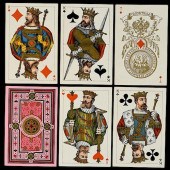 THE STATE PRINTING WORKS.The
THE STATE PRINTING WORKS.The State Printing Works. St. Petersburg, ca. 1863. 52. Near mint. Paul de la Rue, brother of the famous English card maker Thomas de la Rue, was commissioned to take charge training Russian personnel in the art of printing in color. This pack is one of the results. The courts bearing gold illumination.
THE STATE PRINTING WORKS.The
THE STATE PRINTING WORKS.The State Printing Works. St. Petersburg, ca. 1863. 52. Near mint. Paul de la Rue, brother of the famous English card maker Thomas de la Rue, was commissioned to take charge training Russian personnel in the art of printing in color. This pack is one of the results. The courts bearing gold illumination. -
 LLOYD KELLY ACRYLIC ON CANVAS OF
LLOYD KELLY ACRYLIC ON CANVAS OF DAFFODILLloyd Kelly (American, b.1946) acrylic on canvas depicting a flower; signed and dated to bottom left corner "Lloyd Kelly 1993" as well as signed to back; measures approximately 17" x 15" with frame and has a sight image of approximately 13-9/16" x 11-9/16"; in Good overall condition. Lloyd Kelly is an internationally acclaimed artist whose paintings are rendered in an honest, straight-forward style, characterized by acute observation and meticulous technique. The results are paintings that bound forward with forcefulness and originality. Kelly was born in 1946 in New Orleans and began his art studies at the University of Nebraska, where in 1973 he obtained a Bachelorï¾’s Degree in Drawing, and then a Masterï¾’s Degree in Fine Arts and Printmaking from the University of Guanajuato, Mexico in 1975. Soon after, he attended the Arts Students League in New York City and finally traveled to Europe for museums studies at the Louvre and Tate Gallery.
LLOYD KELLY ACRYLIC ON CANVAS OF
LLOYD KELLY ACRYLIC ON CANVAS OF DAFFODILLloyd Kelly (American, b.1946) acrylic on canvas depicting a flower; signed and dated to bottom left corner "Lloyd Kelly 1993" as well as signed to back; measures approximately 17" x 15" with frame and has a sight image of approximately 13-9/16" x 11-9/16"; in Good overall condition. Lloyd Kelly is an internationally acclaimed artist whose paintings are rendered in an honest, straight-forward style, characterized by acute observation and meticulous technique. The results are paintings that bound forward with forcefulness and originality. Kelly was born in 1946 in New Orleans and began his art studies at the University of Nebraska, where in 1973 he obtained a Bachelorï¾’s Degree in Drawing, and then a Masterï¾’s Degree in Fine Arts and Printmaking from the University of Guanajuato, Mexico in 1975. Soon after, he attended the Arts Students League in New York City and finally traveled to Europe for museums studies at the Louvre and Tate Gallery. -
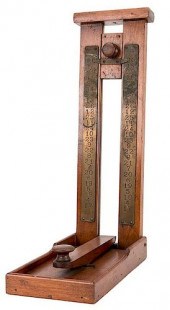 GAFFED WORLD’S FAIR HIGH
GAFFED WORLD’S FAIR HIGH STRIKER.Gaffed World’s Fair High Striker. Chicago: H.C. Evans, ca. 1915. Attractive and small hardwood high striker used as a trade stimulator in saloons. Engraved brass number plates, wooden construction. Folds for storage. 22” high. Cleverly gaffed so the results can be controlled by the operator.
GAFFED WORLD’S FAIR HIGH
GAFFED WORLD’S FAIR HIGH STRIKER.Gaffed World’s Fair High Striker. Chicago: H.C. Evans, ca. 1915. Attractive and small hardwood high striker used as a trade stimulator in saloons. Engraved brass number plates, wooden construction. Folds for storage. 22” high. Cleverly gaffed so the results can be controlled by the operator. -
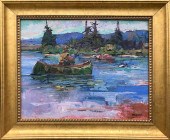 DAVID LAZARUS OIL ON CANVAS "LONE
DAVID LAZARUS OIL ON CANVAS "LONE FISHERMAN IN CANOE"David Lazarus (British-American, b. 1952) Oil on Canvas "Lone Fisherman in Canoe" , depicted on a lake in a mountainous wooded lakescape, signed lower right D. Lazarus. 15 ¾ in. x 19 ¼ in. Overall 21 in. x 25 in. David Lazarus (British-American, b. 1952) David Lazarus was born in London, England, and counts among his early artistic experiences a fascination with the art of scrimshaw. The miniature scale of this medium suited him well, as it enabled him to travel with a studio the size of a cigar box. Eventually settling on Nantucket, Lazarus established himself as one of the island's premier artists. During the last 20 years, Lazarus has devoted more time to painting in oils. "The looseness of pushing paint around, after having engraved miles of tiny lines, has been liberating as well as challenging." Lazarus explains. David's work recalls a modern-day Frank W. Benson in terms of his brushwork. His work is bright, vivid and full of light. His impressionist style allows him to move the paint around the canvas and place it just so. His paintings are a high-wire act with risks and rewards. Sometimes the paint can get a little muddied and he literally discards those works into the trash. But when he nails them, which is more often than not, the results are amazing. ~ Stephen O'Brien, Stephen O'Brien Jr. Fine Arts, LLC, Boston. Lazarus studied at the Bath Academy of Art in England. He came to Nantucket to do scrimshaw in the 1970s, having spent time working with the scrimshanders in Bellingham, Washington. He first scrimmed for the Four Winds Craft Guild. Lazarus continues to expand his oeuvre with meticulous copper engravings, watercolor and oils. He has exhibited at the (X) Gallery, the Old Spouter Gallery and the South Wharf Gallery, and continues to be represented by Four Winds Craft Guild. His work is in numerous private and public collections. Condition: Items may have wear and tear, imperfections or the effects of aging. Please contact the gallery for further details prior to bidding. Any condition statement given as a courtesy should not be treated as fact.
DAVID LAZARUS OIL ON CANVAS "LONE
DAVID LAZARUS OIL ON CANVAS "LONE FISHERMAN IN CANOE"David Lazarus (British-American, b. 1952) Oil on Canvas "Lone Fisherman in Canoe" , depicted on a lake in a mountainous wooded lakescape, signed lower right D. Lazarus. 15 ¾ in. x 19 ¼ in. Overall 21 in. x 25 in. David Lazarus (British-American, b. 1952) David Lazarus was born in London, England, and counts among his early artistic experiences a fascination with the art of scrimshaw. The miniature scale of this medium suited him well, as it enabled him to travel with a studio the size of a cigar box. Eventually settling on Nantucket, Lazarus established himself as one of the island's premier artists. During the last 20 years, Lazarus has devoted more time to painting in oils. "The looseness of pushing paint around, after having engraved miles of tiny lines, has been liberating as well as challenging." Lazarus explains. David's work recalls a modern-day Frank W. Benson in terms of his brushwork. His work is bright, vivid and full of light. His impressionist style allows him to move the paint around the canvas and place it just so. His paintings are a high-wire act with risks and rewards. Sometimes the paint can get a little muddied and he literally discards those works into the trash. But when he nails them, which is more often than not, the results are amazing. ~ Stephen O'Brien, Stephen O'Brien Jr. Fine Arts, LLC, Boston. Lazarus studied at the Bath Academy of Art in England. He came to Nantucket to do scrimshaw in the 1970s, having spent time working with the scrimshanders in Bellingham, Washington. He first scrimmed for the Four Winds Craft Guild. Lazarus continues to expand his oeuvre with meticulous copper engravings, watercolor and oils. He has exhibited at the (X) Gallery, the Old Spouter Gallery and the South Wharf Gallery, and continues to be represented by Four Winds Craft Guild. His work is in numerous private and public collections. Condition: Items may have wear and tear, imperfections or the effects of aging. Please contact the gallery for further details prior to bidding. Any condition statement given as a courtesy should not be treated as fact. -
 DAVID LAZARUS OIL ON CANVAS
DAVID LAZARUS OIL ON CANVAS "THREE FISHERMAN IN A CANOE...David Lazarus (British-American, b. 1952) Oil on Canvas "Three Fisherman in a Canoe" , depicted in a mountainous wooded lake-scape, unsigned, in gilt frame 23 ½ in. x 29 ¼ in. David Lazarus was born in London, England, and counts among his early artistic experiences a fascination with the art of scrimshaw. The miniature scale of this medium suited him well, as it enabled him to travel with a studio the size of a cigar box. Eventually settling on Nantucket, Lazarus established himself as one of the island's premier artists. During the last 20 years, Lazarus has devoted more time to painting in oils. ‰ÛÏThe looseness of pushing paint around, after having engraved miles of tiny lines, has been liberating as well as challenging,‰Û Lazarus explains. David‰Ûªs work recalls a modern-day Frank W. Benson in terms of his brushwork. His work is bright, vivid and full of light. His impressionist style allows him to move the paint around the canvas and place it just so. His paintings are a high-wire act with risks and rewards. Sometimes the paint can get a little muddied and he literally discards those works into the trash. But when he nails them, which is more often than not, the results are amazing.‰Û ~ Stephen O‰ÛªBrien, Stephen O‰ÛªBrien Jr. Fine Arts, LLC, Boston Lazarus studied at the Bath Academy of Art in England. He came to Nantucket to do scrimshaw in the 1970‰Ûªs, having spent time working with the scrimshanders in Bellingham, Washington. He first scrimmed for the Four Winds Craft Guild. Lazarus continues to expand his oeuvre with meticulous copper engravings, watercolor and oils. He has exhibited at the (X) Gallery, the Old Spouter Gallery and the South Wharf Gallery, and continues to be represented by Four Winds Craft Guild. His work is in numerous private and public collections. Condition: Items may have wear and tear, imperfections or the effects of aging. Please contact the gallery for further details prior to bidding. Any condition statement given as a courtesy should not be treated as fact.
DAVID LAZARUS OIL ON CANVAS
DAVID LAZARUS OIL ON CANVAS "THREE FISHERMAN IN A CANOE...David Lazarus (British-American, b. 1952) Oil on Canvas "Three Fisherman in a Canoe" , depicted in a mountainous wooded lake-scape, unsigned, in gilt frame 23 ½ in. x 29 ¼ in. David Lazarus was born in London, England, and counts among his early artistic experiences a fascination with the art of scrimshaw. The miniature scale of this medium suited him well, as it enabled him to travel with a studio the size of a cigar box. Eventually settling on Nantucket, Lazarus established himself as one of the island's premier artists. During the last 20 years, Lazarus has devoted more time to painting in oils. ‰ÛÏThe looseness of pushing paint around, after having engraved miles of tiny lines, has been liberating as well as challenging,‰Û Lazarus explains. David‰Ûªs work recalls a modern-day Frank W. Benson in terms of his brushwork. His work is bright, vivid and full of light. His impressionist style allows him to move the paint around the canvas and place it just so. His paintings are a high-wire act with risks and rewards. Sometimes the paint can get a little muddied and he literally discards those works into the trash. But when he nails them, which is more often than not, the results are amazing.‰Û ~ Stephen O‰ÛªBrien, Stephen O‰ÛªBrien Jr. Fine Arts, LLC, Boston Lazarus studied at the Bath Academy of Art in England. He came to Nantucket to do scrimshaw in the 1970‰Ûªs, having spent time working with the scrimshanders in Bellingham, Washington. He first scrimmed for the Four Winds Craft Guild. Lazarus continues to expand his oeuvre with meticulous copper engravings, watercolor and oils. He has exhibited at the (X) Gallery, the Old Spouter Gallery and the South Wharf Gallery, and continues to be represented by Four Winds Craft Guild. His work is in numerous private and public collections. Condition: Items may have wear and tear, imperfections or the effects of aging. Please contact the gallery for further details prior to bidding. Any condition statement given as a courtesy should not be treated as fact. -
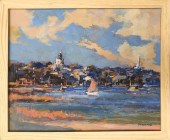 DAVID LAZARUS ACRYLIC ON BOARD
DAVID LAZARUS ACRYLIC ON BOARD "NANTUCKET TOWN"David Lazarus (b. 1952) Acrylic on Board "Nantucket Town" , depicting the skyline of Nantucket from Monomoy, signed lower right D. Lazarus 11 in. x 14 in. Overall 12 in. x 15 in. “David Lazarus was born in London, England, and counts among his early artistic experiences a fascination with the art of scrimshaw. The miniature scale of this medium suited him well, as it enabled him to travel with a studio the size of a cigar box. Eventually settling on Nantucket, Lazarus established himself as one of the island’s premier artists. During the last 20 years, Lazarus has devoted more time to painting in oils. “The looseness of pushing paint around, after having engraved miles of tiny lines, has been liberating as well as challenging,” Lazarus explains. David’s work recalls a modern-day Frank W. Benson in terms of his brushwork. His work is bright, vivid and full of light. His impressionist style allows him to move the paint around the canvas and place it just so. His paintings are a high-wire act with risks and rewards. Sometimes the paint can get a little muddied and he literally discards those works into the trash. But when he nails them, which is more often than not, the results are amazing.” Condition: Items may have wear and tear, imperfections or the effects of aging. Please contact the gallery for further details prior to bidding. Any condition statement given as a courtesy should not be treated as fact.
DAVID LAZARUS ACRYLIC ON BOARD
DAVID LAZARUS ACRYLIC ON BOARD "NANTUCKET TOWN"David Lazarus (b. 1952) Acrylic on Board "Nantucket Town" , depicting the skyline of Nantucket from Monomoy, signed lower right D. Lazarus 11 in. x 14 in. Overall 12 in. x 15 in. “David Lazarus was born in London, England, and counts among his early artistic experiences a fascination with the art of scrimshaw. The miniature scale of this medium suited him well, as it enabled him to travel with a studio the size of a cigar box. Eventually settling on Nantucket, Lazarus established himself as one of the island’s premier artists. During the last 20 years, Lazarus has devoted more time to painting in oils. “The looseness of pushing paint around, after having engraved miles of tiny lines, has been liberating as well as challenging,” Lazarus explains. David’s work recalls a modern-day Frank W. Benson in terms of his brushwork. His work is bright, vivid and full of light. His impressionist style allows him to move the paint around the canvas and place it just so. His paintings are a high-wire act with risks and rewards. Sometimes the paint can get a little muddied and he literally discards those works into the trash. But when he nails them, which is more often than not, the results are amazing.” Condition: Items may have wear and tear, imperfections or the effects of aging. Please contact the gallery for further details prior to bidding. Any condition statement given as a courtesy should not be treated as fact. -
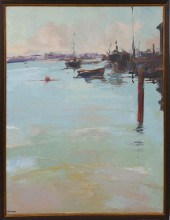 DAVID LAZARUS OIL ON CANVAS
DAVID LAZARUS OIL ON CANVAS "WORKING WATERFRONT"David Lazarus (b. 1952) Oil on Canvas "Working Waterfront" , signed lower left D. Lazarus, in molded wood frame with gilt liner 32 in. x 42 in. Overall 36 in. x 46 in. David Lazarus (British-American, b. 1952) “David Lazarus was born in London, England, and counts among his early artistic experiences a fascination with the art of scrimshaw. The miniature scale of this medium suited him well, as it enabled him to travel with a studio the size of a cigar box. Eventually settling on Nantucket, Lazarus established himself as one of the island’s premier artists. During the last 20 years, Lazarus has devoted more time to painting in oils. “The looseness of pushing paint around, after having engraved miles of tiny lines, has been liberating as well as challenging,” Lazarus explains. David’s work recalls a modern-day Frank W. Benson in terms of his brushwork. His work is bright, vivid and full of light. His impressionist style allows him to move the paint around the canvas and place it just so. His paintings are a high-wire act with risks and rewards. Sometimes the paint can get a little muddied and he literally discards those works into the trash. But when he nails them, which is more often than not, the results are amazing.” Condition: Items may have wear and tear, imperfections or the effects of aging. Please contact the gallery for further details prior to bidding. Any condition statement given as a courtesy should not be treated as fact.
DAVID LAZARUS OIL ON CANVAS
DAVID LAZARUS OIL ON CANVAS "WORKING WATERFRONT"David Lazarus (b. 1952) Oil on Canvas "Working Waterfront" , signed lower left D. Lazarus, in molded wood frame with gilt liner 32 in. x 42 in. Overall 36 in. x 46 in. David Lazarus (British-American, b. 1952) “David Lazarus was born in London, England, and counts among his early artistic experiences a fascination with the art of scrimshaw. The miniature scale of this medium suited him well, as it enabled him to travel with a studio the size of a cigar box. Eventually settling on Nantucket, Lazarus established himself as one of the island’s premier artists. During the last 20 years, Lazarus has devoted more time to painting in oils. “The looseness of pushing paint around, after having engraved miles of tiny lines, has been liberating as well as challenging,” Lazarus explains. David’s work recalls a modern-day Frank W. Benson in terms of his brushwork. His work is bright, vivid and full of light. His impressionist style allows him to move the paint around the canvas and place it just so. His paintings are a high-wire act with risks and rewards. Sometimes the paint can get a little muddied and he literally discards those works into the trash. But when he nails them, which is more often than not, the results are amazing.” Condition: Items may have wear and tear, imperfections or the effects of aging. Please contact the gallery for further details prior to bidding. Any condition statement given as a courtesy should not be treated as fact. -
 DAVID LAZARUS ACRYLIC ON CANVAS
DAVID LAZARUS ACRYLIC ON CANVAS "SAND ROAD TO THE BEACH...David Lazarus (British-American b. 1952) Acrylic on Canvas "Sand Road to the Beach", signed lower right D Lazarus 24 in. x 24 in. David Lazarus (British-American, b. 1952) “David Lazarus was born in London, England, and counts among his early artistic experiences a fascination with the art of scrimshaw. The miniature scale of this medium suited him well, as it enabled him to travel with a studio the size of a cigar box. Eventually settling on Nantucket, Lazarus established himself as one of the island’s premier artists. During the last 20 years, Lazarus has devoted more time to painting in oils. “The looseness of pushing paint around, after having engraved miles of tiny lines, has been liberating as well as challenging,” Lazarus explains. David’s work recalls a modern-day Frank W. Benson in terms of his brushwork. His work is bright, vivid and full of light. His impressionist style allows him to move the paint around the canvas and place it just so. His paintings are a high-wire act with risks and rewards. Sometimes the paint can get a little muddied and he literally discards those works into the trash. But when he nails them, which is more often than not, the results are amazing.” Condition: Items may have wear and tear, imperfections or the effects of aging. Please contact the gallery for further details prior to bidding. Any condition statement given as a courtesy should not be treated as fact.
DAVID LAZARUS ACRYLIC ON CANVAS
DAVID LAZARUS ACRYLIC ON CANVAS "SAND ROAD TO THE BEACH...David Lazarus (British-American b. 1952) Acrylic on Canvas "Sand Road to the Beach", signed lower right D Lazarus 24 in. x 24 in. David Lazarus (British-American, b. 1952) “David Lazarus was born in London, England, and counts among his early artistic experiences a fascination with the art of scrimshaw. The miniature scale of this medium suited him well, as it enabled him to travel with a studio the size of a cigar box. Eventually settling on Nantucket, Lazarus established himself as one of the island’s premier artists. During the last 20 years, Lazarus has devoted more time to painting in oils. “The looseness of pushing paint around, after having engraved miles of tiny lines, has been liberating as well as challenging,” Lazarus explains. David’s work recalls a modern-day Frank W. Benson in terms of his brushwork. His work is bright, vivid and full of light. His impressionist style allows him to move the paint around the canvas and place it just so. His paintings are a high-wire act with risks and rewards. Sometimes the paint can get a little muddied and he literally discards those works into the trash. But when he nails them, which is more often than not, the results are amazing.” Condition: Items may have wear and tear, imperfections or the effects of aging. Please contact the gallery for further details prior to bidding. Any condition statement given as a courtesy should not be treated as fact. -
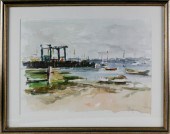 DAVID LAZARUS WATERCOLOR ON PAPER
DAVID LAZARUS WATERCOLOR ON PAPER "HARBOR SEASCAPE"David Lazarus (b. 1952) Watercolor on Paper "Harbor Seascape" , signed lower right in molded wood frame 10 in. x 13.75 in. Overall 14.25 in. x 17.75 in. David Lazarus (British-American, b. 1952) “David Lazarus was born in London, England, and counts among his early artistic experiences a fascination with the art of scrimshaw. The miniature scale of this medium suited him well, as it enabled him to travel with a studio the size of a cigar box. Eventually settling on Nantucket, Lazarus established himself as one of the island’s premier artists. During the last 20 years, Lazarus has devoted more time to painting in oils. “The looseness of pushing paint around, after having engraved miles of tiny lines, has been liberating as well as challenging,” Lazarus explains. David’s work recalls a modern-day Frank W. Benson in terms of his brushwork. His work is bright, vivid and full of light. His impressionist style allows him to move the paint around the canvas and place it just so. His paintings are a high-wire act with risks and rewards. Sometimes the paint can get a little muddied and he literally discards those works into the trash. But when he nails them, which is more often than not, the results are amazing.” Condition: Items may have wear and tear, imperfections or the effects of aging. Please contact the gallery for further details prior to bidding. Any condition statement given as a courtesy should not be treated as fact.
DAVID LAZARUS WATERCOLOR ON PAPER
DAVID LAZARUS WATERCOLOR ON PAPER "HARBOR SEASCAPE"David Lazarus (b. 1952) Watercolor on Paper "Harbor Seascape" , signed lower right in molded wood frame 10 in. x 13.75 in. Overall 14.25 in. x 17.75 in. David Lazarus (British-American, b. 1952) “David Lazarus was born in London, England, and counts among his early artistic experiences a fascination with the art of scrimshaw. The miniature scale of this medium suited him well, as it enabled him to travel with a studio the size of a cigar box. Eventually settling on Nantucket, Lazarus established himself as one of the island’s premier artists. During the last 20 years, Lazarus has devoted more time to painting in oils. “The looseness of pushing paint around, after having engraved miles of tiny lines, has been liberating as well as challenging,” Lazarus explains. David’s work recalls a modern-day Frank W. Benson in terms of his brushwork. His work is bright, vivid and full of light. His impressionist style allows him to move the paint around the canvas and place it just so. His paintings are a high-wire act with risks and rewards. Sometimes the paint can get a little muddied and he literally discards those works into the trash. But when he nails them, which is more often than not, the results are amazing.” Condition: Items may have wear and tear, imperfections or the effects of aging. Please contact the gallery for further details prior to bidding. Any condition statement given as a courtesy should not be treated as fact. -
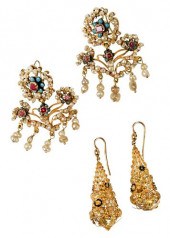 TWO PAIRS ANTIQUE GOLD
TWO PAIRS ANTIQUE GOLD EARRINGScannetille and resin design, cannetille tested 18kt. yellow gold, 2 x 3/4 in., 7.8 grams; girandole design drop earrings, seed pearls, table cut rubies, blue enamel, mounting tested 14kt. yellow gold, stamped "ET", 2 x 1-3/4 in., 23.3 grams Provenance: Estate of the Artists James McBey and Marguerite McBey, London, England; by descent in family Note: In 1980, Marguerite Loeb McBey donated a group of similar jewelry to The Metropolitan Museum of Art, New York. Items were highlighted in an exhibition titled "The Eighteenth-Century Woman, An Exhibition at the Costume Institute, December 12, 1981." To view Marguerite McBey's collection at The Metropolitan Museum of Art please visit: https://www.metmuseum.org/search-results#!/search?q=marguerite%20mcbey&orderByCountDesc=true&page=1 Condition: cannetille and resin, one earring misshapen at bottom and missing finial- appears to have lead solder from previous repair, tarnish, dents- one earrings entirely missing pearls, other with heavy pearl losses- some strings visible, losses to blue resin; drop earrings, enameled parts appear to be non-gold, tarnish, some ends of wire wrapping for pearls untwisted, likely not on original earhooks
TWO PAIRS ANTIQUE GOLD
TWO PAIRS ANTIQUE GOLD EARRINGScannetille and resin design, cannetille tested 18kt. yellow gold, 2 x 3/4 in., 7.8 grams; girandole design drop earrings, seed pearls, table cut rubies, blue enamel, mounting tested 14kt. yellow gold, stamped "ET", 2 x 1-3/4 in., 23.3 grams Provenance: Estate of the Artists James McBey and Marguerite McBey, London, England; by descent in family Note: In 1980, Marguerite Loeb McBey donated a group of similar jewelry to The Metropolitan Museum of Art, New York. Items were highlighted in an exhibition titled "The Eighteenth-Century Woman, An Exhibition at the Costume Institute, December 12, 1981." To view Marguerite McBey's collection at The Metropolitan Museum of Art please visit: https://www.metmuseum.org/search-results#!/search?q=marguerite%20mcbey&orderByCountDesc=true&page=1 Condition: cannetille and resin, one earring misshapen at bottom and missing finial- appears to have lead solder from previous repair, tarnish, dents- one earrings entirely missing pearls, other with heavy pearl losses- some strings visible, losses to blue resin; drop earrings, enameled parts appear to be non-gold, tarnish, some ends of wire wrapping for pearls untwisted, likely not on original earhooks -
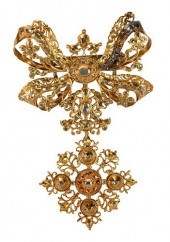 GEORGIAN GOLD & DIAMOND BROOCHbow
GEORGIAN GOLD & DIAMOND BROOCHbow form design, assorted rose and table cut diamonds, stamped "ZA" (?) and with rampant lion (?), tested at least 14kt. yellow gold, hand engraved/scratches "3426", 3-3/4 x 2-3/8 in., 32.1 grams, in fitted box from Harvey & Gore, London Provenance: Estate of the Artists James McBey and Marguerite McBey, London, England; by descent in family Note: Likely listed as item 44 in Mrs. McBey's 1935 insurance appraisal, listed as "A Spanish Three-piece Corsage with Bow Top of Fine Gold and Table Diamonds. XVIIIth Century"In 1980, Marguerite Loeb McBey donated a group of similar jewelry to The Metropolitan Museum of Art, New York. Items were highlighted in an exhibition titled "The Eighteenth-Century Woman, An Exhibition at the Costume Institute, December 12, 1981." To view Marguerite McBey's collection at The Metropolitan Museum of Art please visit: https://www.metmuseum.org/search-results#!/search?q=marguerite%20mcbey&orderByCountDesc=true&page=1 Condition: areas of repair/revisions, visible solder- mostly to back, stamps hard to read, areas of tarnish, wear to some bezels, wear to box
GEORGIAN GOLD & DIAMOND BROOCHbow
GEORGIAN GOLD & DIAMOND BROOCHbow form design, assorted rose and table cut diamonds, stamped "ZA" (?) and with rampant lion (?), tested at least 14kt. yellow gold, hand engraved/scratches "3426", 3-3/4 x 2-3/8 in., 32.1 grams, in fitted box from Harvey & Gore, London Provenance: Estate of the Artists James McBey and Marguerite McBey, London, England; by descent in family Note: Likely listed as item 44 in Mrs. McBey's 1935 insurance appraisal, listed as "A Spanish Three-piece Corsage with Bow Top of Fine Gold and Table Diamonds. XVIIIth Century"In 1980, Marguerite Loeb McBey donated a group of similar jewelry to The Metropolitan Museum of Art, New York. Items were highlighted in an exhibition titled "The Eighteenth-Century Woman, An Exhibition at the Costume Institute, December 12, 1981." To view Marguerite McBey's collection at The Metropolitan Museum of Art please visit: https://www.metmuseum.org/search-results#!/search?q=marguerite%20mcbey&orderByCountDesc=true&page=1 Condition: areas of repair/revisions, visible solder- mostly to back, stamps hard to read, areas of tarnish, wear to some bezels, wear to box -
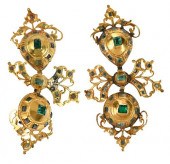 GEORGIAN GOLD GEMSTONE
GEORGIAN GOLD GEMSTONE EARRINGSlikely Spanish, table cut emeralds (a few are paste green stones), tested at least 14kt., illegible stamp on back, 2-3/8 x 1-1/4 in., 12.4 grams Provenance: Estate of the Artists James McBey and Marguerite McBey, London, England; by descent in family Note: See Lot 163, Christie's "Antique and Period Jewels", 2/12/1981In 1980, Marguerite Loeb McBey donated a group of similar jewelry to The Metropolitan Museum of Art, New York. Items were highlighted in an exhibition titled "The Eighteenth-Century Woman, An Exhibition at the Costume Institute, December 12, 1981." To view Marguerite McBey's collection at The Metropolitan Museum of Art please visit: https://www.metmuseum.org/search-results#!/search?q=marguerite%20mcbey&orderByCountDesc=true&page=1 Condition: visible repairs and lead solder, heavily dented- mostly on back, earhook broken off/not currently wearable and other broken parts- with lot, tarnish, chips to some stones, missing some stones, scratches, according to image from Christie's 1981 catalog- it appears this pair of earrings has been repaired and reconfigured upside down from the former/original? design
GEORGIAN GOLD GEMSTONE
GEORGIAN GOLD GEMSTONE EARRINGSlikely Spanish, table cut emeralds (a few are paste green stones), tested at least 14kt., illegible stamp on back, 2-3/8 x 1-1/4 in., 12.4 grams Provenance: Estate of the Artists James McBey and Marguerite McBey, London, England; by descent in family Note: See Lot 163, Christie's "Antique and Period Jewels", 2/12/1981In 1980, Marguerite Loeb McBey donated a group of similar jewelry to The Metropolitan Museum of Art, New York. Items were highlighted in an exhibition titled "The Eighteenth-Century Woman, An Exhibition at the Costume Institute, December 12, 1981." To view Marguerite McBey's collection at The Metropolitan Museum of Art please visit: https://www.metmuseum.org/search-results#!/search?q=marguerite%20mcbey&orderByCountDesc=true&page=1 Condition: visible repairs and lead solder, heavily dented- mostly on back, earhook broken off/not currently wearable and other broken parts- with lot, tarnish, chips to some stones, missing some stones, scratches, according to image from Christie's 1981 catalog- it appears this pair of earrings has been repaired and reconfigured upside down from the former/original? design -
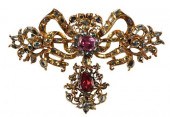 GEORGIAN 18KT. GEMSTONE BROOCHand
GEORGIAN 18KT. GEMSTONE BROOCHand pendant, two convertible pieces, assorted rose and table cut diamonds, one cushion cut foil backed spinel approx. 9 x 7.5mm, one pear cut foil backed spinel approx. 10 x 7.5mm, tested 18kt. yellow gold, 2 x 3 in., 34.2 grams, in fitted box Provenance: Estate of the Artists James McBey and Marguerite McBey, London, England; by descent in family Note: In 1980, Marguerite Loeb McBey donated a group of similar jewelry to The Metropolitan Museum of Art, New York. Items were highlighted in an exhibition titled "The Eighteenth-Century Woman, An Exhibition at the Costume Institute, December 12, 1981." To view Marguerite McBey's collection at The Metropolitan Museum of Art please visit: https://www.metmuseum.org/search-results#!/search?q=marguerite%20mcbey&orderByCountDesc=true&page=1 Condition: tarnish, lead solder spots, pin back likely later addition, glue visible under cushion spinel mounting- possibly later addition or repair??, chips and scratches to some stones, wear and scratches
GEORGIAN 18KT. GEMSTONE BROOCHand
GEORGIAN 18KT. GEMSTONE BROOCHand pendant, two convertible pieces, assorted rose and table cut diamonds, one cushion cut foil backed spinel approx. 9 x 7.5mm, one pear cut foil backed spinel approx. 10 x 7.5mm, tested 18kt. yellow gold, 2 x 3 in., 34.2 grams, in fitted box Provenance: Estate of the Artists James McBey and Marguerite McBey, London, England; by descent in family Note: In 1980, Marguerite Loeb McBey donated a group of similar jewelry to The Metropolitan Museum of Art, New York. Items were highlighted in an exhibition titled "The Eighteenth-Century Woman, An Exhibition at the Costume Institute, December 12, 1981." To view Marguerite McBey's collection at The Metropolitan Museum of Art please visit: https://www.metmuseum.org/search-results#!/search?q=marguerite%20mcbey&orderByCountDesc=true&page=1 Condition: tarnish, lead solder spots, pin back likely later addition, glue visible under cushion spinel mounting- possibly later addition or repair??, chips and scratches to some stones, wear and scratches -
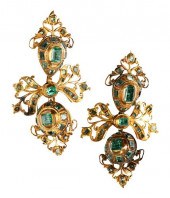 GEORGIAN GOLD AND EMERALD
GEORGIAN GOLD AND EMERALD EARRINGSthree section bow/pendant design, likely Spanish or Portuguese, square and rectangle table cut emeralds, tested at least 14kt. yellow gold, lion stamped on back, 2-1/4 x 1-1/4 in., 14.8 grams Provenance: Estate of the Artists James McBey and Marguerite McBey, London, England; by descent in family Note: See lot 21, Christie's "Antique and Period Jewels" sale, 2/12/1981In 1980, Marguerite Loeb McBey donated a group of similar jewelry to The Metropolitan Museum of Art, New York. Items were highlighted in an exhibition titled "The Eighteenth-Century Woman, An Exhibition at the Costume Institute, December 12, 1981." To view Marguerite McBey's collection at The Metropolitan Museum of Art please visit: https://www.metmuseum.org/search-results#!/search?q=marguerite%20mcbey&orderByCountDesc=true&page=1 Condition: tarnish, chips/losses to some stones, repairs, missing one emerald, one earhook bent/cracked and does not close/latch into hole, wear and scratches
GEORGIAN GOLD AND EMERALD
GEORGIAN GOLD AND EMERALD EARRINGSthree section bow/pendant design, likely Spanish or Portuguese, square and rectangle table cut emeralds, tested at least 14kt. yellow gold, lion stamped on back, 2-1/4 x 1-1/4 in., 14.8 grams Provenance: Estate of the Artists James McBey and Marguerite McBey, London, England; by descent in family Note: See lot 21, Christie's "Antique and Period Jewels" sale, 2/12/1981In 1980, Marguerite Loeb McBey donated a group of similar jewelry to The Metropolitan Museum of Art, New York. Items were highlighted in an exhibition titled "The Eighteenth-Century Woman, An Exhibition at the Costume Institute, December 12, 1981." To view Marguerite McBey's collection at The Metropolitan Museum of Art please visit: https://www.metmuseum.org/search-results#!/search?q=marguerite%20mcbey&orderByCountDesc=true&page=1 Condition: tarnish, chips/losses to some stones, repairs, missing one emerald, one earhook bent/cracked and does not close/latch into hole, wear and scratches -
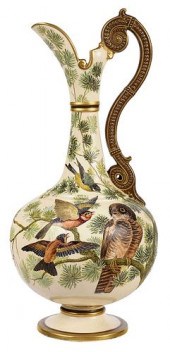 MONUMENTAL FAIENCE MANUFACTURING
MONUMENTAL FAIENCE MANUFACTURING COMPANY EWERAmerican, circa 1886-1890, possibly Edward Lycett decoration, upswept spout and scrolled handle, with gilt and beautifully rendered hand painted enamel decoration of birds amongst leafy tree branches, base marked with "FMCo" monogram and "19.", 22-3/4 x 11 in.; [ Aesthetic Ambitions: Edward Lycett and Brooklyn's Faience Manufacturing Company ] by Barbara Veith, Richmond, Virginia: University of Richmond Museums, 2011 Note: Closely related large scale ewers by Faience Manufacturing Company are in the collections of the Metropolitan Museum of Art (2004.95) and the Brooklyn Museum of Art (1999.1). Accompanied by an article from the Brooklyn Museum, a newspaper excerpt, and some sales results. Similar examples illustrated in [ Aesthetic Ambitions ] on pages 52 and 82. MET: https://www.metmuseum.org/art/collection/search/17794 Brooklyn Museum: https://www.brooklynmuseum.org/opencollection/objects/2500 Provenance: Private Collection, North Carolina Condition: anomalies, loss to gilt, crazing; light wear to extremities, binding loose but intact, many pages starting
MONUMENTAL FAIENCE MANUFACTURING
MONUMENTAL FAIENCE MANUFACTURING COMPANY EWERAmerican, circa 1886-1890, possibly Edward Lycett decoration, upswept spout and scrolled handle, with gilt and beautifully rendered hand painted enamel decoration of birds amongst leafy tree branches, base marked with "FMCo" monogram and "19.", 22-3/4 x 11 in.; [ Aesthetic Ambitions: Edward Lycett and Brooklyn's Faience Manufacturing Company ] by Barbara Veith, Richmond, Virginia: University of Richmond Museums, 2011 Note: Closely related large scale ewers by Faience Manufacturing Company are in the collections of the Metropolitan Museum of Art (2004.95) and the Brooklyn Museum of Art (1999.1). Accompanied by an article from the Brooklyn Museum, a newspaper excerpt, and some sales results. Similar examples illustrated in [ Aesthetic Ambitions ] on pages 52 and 82. MET: https://www.metmuseum.org/art/collection/search/17794 Brooklyn Museum: https://www.brooklynmuseum.org/opencollection/objects/2500 Provenance: Private Collection, North Carolina Condition: anomalies, loss to gilt, crazing; light wear to extremities, binding loose but intact, many pages starting -
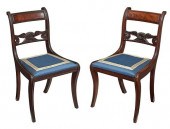 PAIR CLASSICAL EAGLE CARVED EARLY
PAIR CLASSICAL EAGLE CARVED EARLY SIDE CHAIRS IN EARLY ...New York circa 1820s, each with figured mahogany veneered tablet over a well carved eagle slat, ash secondary, original slip seats and under upholstery now set with embroidered blue fabric, 32-1/2 x 18-1/4 x 19 in. Note: These chairs are identical to a pair at Winterthur Museum (1957.0562.02) and are discussed in Charles F. Montgomery, American Furniture, The Federal Period, pg. 128-129. Montgomery notes "Few chairs of any period excel either this one [or No 76] in beauty... each is the ultimate in simplicity. Carved eagles may sometimes seem incongruous when they appear on tables and sofas. Here [and in No 76] they are so composed as to give a sense of strength to a fragile form." Another example is illustrated in Wendy Cooper, Classical Taste in America, pg. 109. Winterthur (1957.0562.002): http://museumcollection.winterthur.org/single-record.php?resultsperpage=60&view=catalog&srchtype=advanced&hasImage=&ObjObjectName=&CreOrigin=&Earliest=&Latest=&CreCreatorLocal_tab=&materialsearch=&ObjObjectID=&ObjCategory=&DesMaterial_tab=&DesTechnique_tab=&AccCreditLineLocal=&CreMarkSignature=&recid=1957.0562.002&srchfld=&srchtxt=eagle+chair&id=bed7&rownum=1&version=100&src=results-imagelink-only#.YxOeHS-B1KM Background on Important Private Collection from Boston: I have been working with this collector for over 25 years, both in the initial acquisition of the objects and overseeing their conservation as needed. With a keen eye for quality and design, and a deep passion for all things classical, he has quietly amassed a top-notch collection of American furniture and decorative arts. The collection encompasses outstanding examples from the leading cabinetmakers of Boston, New York, and Philadelphia, representing excellence in form and proportions, condition, wood quality, and carving. It also includes rare objects that are among the best of their kind. Now, with the downsizing of one of his properties, the offerings in this catalog are coming to market to find new owners who share a love for this remarkable period in American furniture history. Clark Pearce, Advisor and Consultant to Collectors and Institutions Provenance: by descent from Jacob Ten Eyck (1785 to 1853, Cazenovia, New York); Clark Pearce; Property from an Important Boston Collection Condition: break and repair at one ear, some slight color variation, one fabric seat support loose, modern upholstery good overall with light wear and fading
PAIR CLASSICAL EAGLE CARVED EARLY
PAIR CLASSICAL EAGLE CARVED EARLY SIDE CHAIRS IN EARLY ...New York circa 1820s, each with figured mahogany veneered tablet over a well carved eagle slat, ash secondary, original slip seats and under upholstery now set with embroidered blue fabric, 32-1/2 x 18-1/4 x 19 in. Note: These chairs are identical to a pair at Winterthur Museum (1957.0562.02) and are discussed in Charles F. Montgomery, American Furniture, The Federal Period, pg. 128-129. Montgomery notes "Few chairs of any period excel either this one [or No 76] in beauty... each is the ultimate in simplicity. Carved eagles may sometimes seem incongruous when they appear on tables and sofas. Here [and in No 76] they are so composed as to give a sense of strength to a fragile form." Another example is illustrated in Wendy Cooper, Classical Taste in America, pg. 109. Winterthur (1957.0562.002): http://museumcollection.winterthur.org/single-record.php?resultsperpage=60&view=catalog&srchtype=advanced&hasImage=&ObjObjectName=&CreOrigin=&Earliest=&Latest=&CreCreatorLocal_tab=&materialsearch=&ObjObjectID=&ObjCategory=&DesMaterial_tab=&DesTechnique_tab=&AccCreditLineLocal=&CreMarkSignature=&recid=1957.0562.002&srchfld=&srchtxt=eagle+chair&id=bed7&rownum=1&version=100&src=results-imagelink-only#.YxOeHS-B1KM Background on Important Private Collection from Boston: I have been working with this collector for over 25 years, both in the initial acquisition of the objects and overseeing their conservation as needed. With a keen eye for quality and design, and a deep passion for all things classical, he has quietly amassed a top-notch collection of American furniture and decorative arts. The collection encompasses outstanding examples from the leading cabinetmakers of Boston, New York, and Philadelphia, representing excellence in form and proportions, condition, wood quality, and carving. It also includes rare objects that are among the best of their kind. Now, with the downsizing of one of his properties, the offerings in this catalog are coming to market to find new owners who share a love for this remarkable period in American furniture history. Clark Pearce, Advisor and Consultant to Collectors and Institutions Provenance: by descent from Jacob Ten Eyck (1785 to 1853, Cazenovia, New York); Clark Pearce; Property from an Important Boston Collection Condition: break and repair at one ear, some slight color variation, one fabric seat support loose, modern upholstery good overall with light wear and fading -
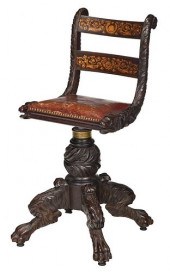 RARE AMERICAN CLASSICAL DOLPHIN
RARE AMERICAN CLASSICAL DOLPHIN FIGURAL PIANO STOOLNew York, 1825-1835, in a remarkable state of preservation, with stenciled back and stylized dolphin carved supports, original red leather set with brass tacking, swiveling on a leaf carved support with pedestal base and lions claw feet, base with traces of gilding or yellow paint and verdigris, 31-1/4 x 15-1/4 x 15-1/4 in. Note: A virtually identical example is at Winterthur (1967.1937). Another related stool is pictured in Cooper, Classical Taste in America , page 266. Winterthur- http://museumcollection.winterthur.org/single-record.php?resultsperpage=60&view=catalog&srchtype=advanced&hasImage=&ObjObjectName=&CreOrigin=&Earliest=&Latest=&CreCreatorLocal_tab=&materialsearch=&ObjObjectID=&ObjCategory=&DesMaterial_tab=&DesTechnique_tab=&AccCreditLineLocal=&CreMarkSignature=&recid=1967.1937&srchfld=&srchtxt=stool&id=3592&rownum=121&version=100&src=results-imagelink-only#.YxOb6S-B1KM Background on Important Private Collection from Boston: I have been working with this collector for over 25 years, both in the initial acquisition of the objects and overseeing their conservation as needed. With a keen eye for quality and design, and a deep passion for all things classical, he has quietly amassed a top-notch collection of American furniture and decorative arts. The collection encompasses outstanding examples from the leading cabinetmakers of Boston, New York, and Philadelphia, representing excellence in form and proportions, condition, wood quality, and carving. It also includes rare objects that are among the best of their kind. Now, with the downsizing of one of his properties, the offerings in this catalog are coming to market to find new owners who share a love for this remarkable period in American furniture history. Clark Pearce, Advisor and Consultant to Collectors and Institutions Provenance: Clark Pearce; Property from an Important Boston Collection Condition: probably original surface throughout, probably original upholstery with cracking and wear, rear stiles with probable repairs at curves (or possible retouch at lamination as made), one rear stile with early crack and screw repair, minor restoration and color retouch at one toe, swivel support fits loosely in base
RARE AMERICAN CLASSICAL DOLPHIN
RARE AMERICAN CLASSICAL DOLPHIN FIGURAL PIANO STOOLNew York, 1825-1835, in a remarkable state of preservation, with stenciled back and stylized dolphin carved supports, original red leather set with brass tacking, swiveling on a leaf carved support with pedestal base and lions claw feet, base with traces of gilding or yellow paint and verdigris, 31-1/4 x 15-1/4 x 15-1/4 in. Note: A virtually identical example is at Winterthur (1967.1937). Another related stool is pictured in Cooper, Classical Taste in America , page 266. Winterthur- http://museumcollection.winterthur.org/single-record.php?resultsperpage=60&view=catalog&srchtype=advanced&hasImage=&ObjObjectName=&CreOrigin=&Earliest=&Latest=&CreCreatorLocal_tab=&materialsearch=&ObjObjectID=&ObjCategory=&DesMaterial_tab=&DesTechnique_tab=&AccCreditLineLocal=&CreMarkSignature=&recid=1967.1937&srchfld=&srchtxt=stool&id=3592&rownum=121&version=100&src=results-imagelink-only#.YxOb6S-B1KM Background on Important Private Collection from Boston: I have been working with this collector for over 25 years, both in the initial acquisition of the objects and overseeing their conservation as needed. With a keen eye for quality and design, and a deep passion for all things classical, he has quietly amassed a top-notch collection of American furniture and decorative arts. The collection encompasses outstanding examples from the leading cabinetmakers of Boston, New York, and Philadelphia, representing excellence in form and proportions, condition, wood quality, and carving. It also includes rare objects that are among the best of their kind. Now, with the downsizing of one of his properties, the offerings in this catalog are coming to market to find new owners who share a love for this remarkable period in American furniture history. Clark Pearce, Advisor and Consultant to Collectors and Institutions Provenance: Clark Pearce; Property from an Important Boston Collection Condition: probably original surface throughout, probably original upholstery with cracking and wear, rear stiles with probable repairs at curves (or possible retouch at lamination as made), one rear stile with early crack and screw repair, minor restoration and color retouch at one toe, swivel support fits loosely in base -
 FINE ASSEMBLED PAIR PHILADELPHIA
FINE ASSEMBLED PAIR PHILADELPHIA CLASSICAL CARD TABLESattributed to Anthony Quervelle, circa 1830, each with rotating fold over top, each with figured and segmented top with rosewood banded surround and stencil decoration, set on carved and parcel gilt supports, pedestal bases with leaf and scroll carved legs with lions paw feet and brass casters, 29 x 39 x 19-1/2 in. Note: While these tables are nearly identical there are subtle differences in the carving, stenciling, and construction details indicates that they were not made as a pair. Winterthur (1965.0103.001): http://museumcollection.winterthur.org/single-record.php?resultsperpage=20&view=catalog&srchtype=advanced&hasImage=&ObjObjectName=&CreOrigin=&Earliest=&Latest=&CreCreatorLocal_tab=&materialsearch=&ObjObjectID=&ObjCategory=&DesMaterial_tab=&DesTechnique_tab=&AccCreditLineLocal=&CreMarkSignature=&recid=1965.0103.001&srchfld=&srchtxt=card+table&id=bed1&rownum=81&version=100&src=results-imagelink-only#.Ytc5Ri-B3BI The Met (43.132.2): https://www.metmuseum.org/art/collection/search/1452?ft=card+table&offset=0&rpp=40&pos=32). Background on Important Private Collection from Boston: I have been working with this collector for over 25 years, both in the initial acquisition of the objects and overseeing their conservation as needed. With a keen eye for quality and design, and a deep passion for all things classical, he has quietly amassed a top-notch collection of American furniture and decorative arts. The collection encompasses outstanding examples from the leading cabinetmakers of Boston, New York, and Philadelphia, representing excellence in form and proportions, condition, wood quality, and carving. It also includes rare objects that are among the best of their kind. Now, with the downsizing of one of his properties, the offerings in this catalog are coming to market to find new owners who share a love for this remarkable period in American furniture history. Clark Pearce, Advisor and Consultant to Collectors and Institutions Provenance: Freemen's, Philadelphia, November 19, 2006 for $21,250 and the second also Freeman's, April 22, 2007 for $25,000; Clark Pearce; Property from an Important Boston Collection Condition: Conserved by Chris Thompson in Salem, Massachusetts, with analysis of of surviving gilding and restoration of decoration on carved elements; both in good condition overall, gilding restored, typical veneer cracks and flaws especially at pedestal bases (one pedestal base with some warping and one replaced castor), minor chips and repairs at foot scrolls, scattered retouch to stenciling, minor warping to tops
FINE ASSEMBLED PAIR PHILADELPHIA
FINE ASSEMBLED PAIR PHILADELPHIA CLASSICAL CARD TABLESattributed to Anthony Quervelle, circa 1830, each with rotating fold over top, each with figured and segmented top with rosewood banded surround and stencil decoration, set on carved and parcel gilt supports, pedestal bases with leaf and scroll carved legs with lions paw feet and brass casters, 29 x 39 x 19-1/2 in. Note: While these tables are nearly identical there are subtle differences in the carving, stenciling, and construction details indicates that they were not made as a pair. Winterthur (1965.0103.001): http://museumcollection.winterthur.org/single-record.php?resultsperpage=20&view=catalog&srchtype=advanced&hasImage=&ObjObjectName=&CreOrigin=&Earliest=&Latest=&CreCreatorLocal_tab=&materialsearch=&ObjObjectID=&ObjCategory=&DesMaterial_tab=&DesTechnique_tab=&AccCreditLineLocal=&CreMarkSignature=&recid=1965.0103.001&srchfld=&srchtxt=card+table&id=bed1&rownum=81&version=100&src=results-imagelink-only#.Ytc5Ri-B3BI The Met (43.132.2): https://www.metmuseum.org/art/collection/search/1452?ft=card+table&offset=0&rpp=40&pos=32). Background on Important Private Collection from Boston: I have been working with this collector for over 25 years, both in the initial acquisition of the objects and overseeing their conservation as needed. With a keen eye for quality and design, and a deep passion for all things classical, he has quietly amassed a top-notch collection of American furniture and decorative arts. The collection encompasses outstanding examples from the leading cabinetmakers of Boston, New York, and Philadelphia, representing excellence in form and proportions, condition, wood quality, and carving. It also includes rare objects that are among the best of their kind. Now, with the downsizing of one of his properties, the offerings in this catalog are coming to market to find new owners who share a love for this remarkable period in American furniture history. Clark Pearce, Advisor and Consultant to Collectors and Institutions Provenance: Freemen's, Philadelphia, November 19, 2006 for $21,250 and the second also Freeman's, April 22, 2007 for $25,000; Clark Pearce; Property from an Important Boston Collection Condition: Conserved by Chris Thompson in Salem, Massachusetts, with analysis of of surviving gilding and restoration of decoration on carved elements; both in good condition overall, gilding restored, typical veneer cracks and flaws especially at pedestal bases (one pedestal base with some warping and one replaced castor), minor chips and repairs at foot scrolls, scattered retouch to stenciling, minor warping to tops -
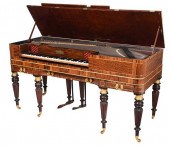 VERY FINE CLASSICAL ROSEWOOD AND
VERY FINE CLASSICAL ROSEWOOD AND BRONZE PIANOFORTE, SAC...brass plaque inscribed "Made by A. Babcock for G. D. MacKay, Boston", circa 1825, highly figured mahogany and rosewood case with ebonizing, brass inlay and moldings, gilt mounts and hardware, original playing mechanism, 34 x 68 x 24 in. ?This lot contains animal or plant material that may be restricted under federal, state and/or local law. Prospective bidders should check all applicable government wildlife restrictions prior to placing a bid. The buyer is solely responsible for obtaining any necessary licenses or permits from federal, state and/or local authorities applicable to their purchase or transport of the object. Please note that bidders in New Jersey may not bid on any lots containing elephant ivory, mammoth ivory, or rhinoceros horn. Note: Illustrated in American Antiques from Israel Sack Collection , Volume VII, pp. 1810-1811, P5029. Sack notes that the piano is also illustrated in Old Time New England Bulletin, 1978, "Pianoforte Manufacturing in 19th century Boston", Nancy A. Smith, figure 4. Sack notes that the original instrumentation is intact. Babcock was a leading piano maker and his instruments had some of the most sophisticated cases made in the period. Similar Babcock pianos are in the collection of the Metropolitan Museum of Art (2001.364A,B) and the Smithsonian (1982.0434.01). Identical Babcock pianos are in the collection of the MFA Boston (1971.1130) and Winterthur (1989.0064). A third identical piano at Historic New England (2005.23.1) is discussed as part of the furnishings prepared in 1824 for Lafayette's visit to Boston (Mussey and Pearce, Rather Elegant than Showy, The Classical Furniture of Isaac Vowes pages 192-193). Identical examples: MFA Boston (1971.1130): https://collections.mfa.org/objects/50888/square-piano?ctx=fe4de107-717e-413e-b45e-00c2becf48bf&idx=13 Winterthur (1989.0064): http://museumcollection.winterthur.org/single-record.php?resultsperpage=20&view=catalog&srchtype=advanced&hasImage=&ObjObjectName=&CreOrigin=&Earliest=&Latest=&CreCreatorLocal_tab=&materialsearch=&ObjObjectID=&ObjCategory=&DesMaterial_tab=&DesTechnique_tab=&AccCreditLineLocal=&CreMarkSignature=&recid=1989.0064&srchfld=&srchtxt=piano&id=fd80&rownum=61&version=100&src=results-imagelink-only#.YxOZJy-B1KN Historic New England (2005.23.1): https://www.historicnewengland.org/explore/collections-access/gusn/189623 Related Babcock examples: The Met (2001.364a, b): https://www.metmuseum.org/art/collection/search/503531 Smithsonian (1982.0434.01): https://americanhistory.si.edu/collections/search/object/nmah_605830 Background on Important Private Collection from Boston: I have been working with this collector for over 25 years, both in the initial acquisition of the objects and overseeing their conservation as needed. With a keen eye for quality and design, and a deep passion for all things classical, he has quietly amassed a top-notch collection of American furniture and decorative arts. The collection encompasses outstanding examples from the leading cabinetmakers of Boston, New York, and Philadelphia, representing excellence in form and proportions, condition, wood quality, and carving. It also includes rare objects that are among the best of their kind. Now, with the downsizing of one of his properties, the offerings in this catalog are coming to market to find new owners who share a love for this remarkable period in American furniture history. Clark Pearce, Advisor and Consultant to Collectors and Institutions Provenance: Israel Sack; Property from an Important Boston Collection Condition: works are original and have been restored (not tested for functionality), finely crafted and in excellent condition overall, some minor sun fading and color variation, restorations and/or re-gilding to some mounts, very minor lifting at some brass inlay, other scattered minor veneer flaws, some small banding losses, minor lifting at ivory keys
VERY FINE CLASSICAL ROSEWOOD AND
VERY FINE CLASSICAL ROSEWOOD AND BRONZE PIANOFORTE, SAC...brass plaque inscribed "Made by A. Babcock for G. D. MacKay, Boston", circa 1825, highly figured mahogany and rosewood case with ebonizing, brass inlay and moldings, gilt mounts and hardware, original playing mechanism, 34 x 68 x 24 in. ?This lot contains animal or plant material that may be restricted under federal, state and/or local law. Prospective bidders should check all applicable government wildlife restrictions prior to placing a bid. The buyer is solely responsible for obtaining any necessary licenses or permits from federal, state and/or local authorities applicable to their purchase or transport of the object. Please note that bidders in New Jersey may not bid on any lots containing elephant ivory, mammoth ivory, or rhinoceros horn. Note: Illustrated in American Antiques from Israel Sack Collection , Volume VII, pp. 1810-1811, P5029. Sack notes that the piano is also illustrated in Old Time New England Bulletin, 1978, "Pianoforte Manufacturing in 19th century Boston", Nancy A. Smith, figure 4. Sack notes that the original instrumentation is intact. Babcock was a leading piano maker and his instruments had some of the most sophisticated cases made in the period. Similar Babcock pianos are in the collection of the Metropolitan Museum of Art (2001.364A,B) and the Smithsonian (1982.0434.01). Identical Babcock pianos are in the collection of the MFA Boston (1971.1130) and Winterthur (1989.0064). A third identical piano at Historic New England (2005.23.1) is discussed as part of the furnishings prepared in 1824 for Lafayette's visit to Boston (Mussey and Pearce, Rather Elegant than Showy, The Classical Furniture of Isaac Vowes pages 192-193). Identical examples: MFA Boston (1971.1130): https://collections.mfa.org/objects/50888/square-piano?ctx=fe4de107-717e-413e-b45e-00c2becf48bf&idx=13 Winterthur (1989.0064): http://museumcollection.winterthur.org/single-record.php?resultsperpage=20&view=catalog&srchtype=advanced&hasImage=&ObjObjectName=&CreOrigin=&Earliest=&Latest=&CreCreatorLocal_tab=&materialsearch=&ObjObjectID=&ObjCategory=&DesMaterial_tab=&DesTechnique_tab=&AccCreditLineLocal=&CreMarkSignature=&recid=1989.0064&srchfld=&srchtxt=piano&id=fd80&rownum=61&version=100&src=results-imagelink-only#.YxOZJy-B1KN Historic New England (2005.23.1): https://www.historicnewengland.org/explore/collections-access/gusn/189623 Related Babcock examples: The Met (2001.364a, b): https://www.metmuseum.org/art/collection/search/503531 Smithsonian (1982.0434.01): https://americanhistory.si.edu/collections/search/object/nmah_605830 Background on Important Private Collection from Boston: I have been working with this collector for over 25 years, both in the initial acquisition of the objects and overseeing their conservation as needed. With a keen eye for quality and design, and a deep passion for all things classical, he has quietly amassed a top-notch collection of American furniture and decorative arts. The collection encompasses outstanding examples from the leading cabinetmakers of Boston, New York, and Philadelphia, representing excellence in form and proportions, condition, wood quality, and carving. It also includes rare objects that are among the best of their kind. Now, with the downsizing of one of his properties, the offerings in this catalog are coming to market to find new owners who share a love for this remarkable period in American furniture history. Clark Pearce, Advisor and Consultant to Collectors and Institutions Provenance: Israel Sack; Property from an Important Boston Collection Condition: works are original and have been restored (not tested for functionality), finely crafted and in excellent condition overall, some minor sun fading and color variation, restorations and/or re-gilding to some mounts, very minor lifting at some brass inlay, other scattered minor veneer flaws, some small banding losses, minor lifting at ivory keys -
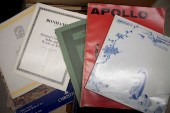 8 LARGE BOXES ASIAN AUCTION
8 LARGE BOXES ASIAN AUCTION CATALOGS 60'S-PRESENTEight Book Boxes filled with Asian auction catalogs to include: Christies, Sotheby's, Bonhams, and more. Ranging from 1960's to present. While there are too many to count, there may be as many as 800 catalogues in total with each of the eight boxes box weighing as much as 60 lbs. Some hard cover, mostly soft covers. Chinese and Japanese, art, pottery, jade, china, etc... Dimensions: Largest is individual9 x 13 inches. (GMAL5346/Lot)(GO) Condition: These boxes are heavy. Fair to good condition. Some have auctions results included.
8 LARGE BOXES ASIAN AUCTION
8 LARGE BOXES ASIAN AUCTION CATALOGS 60'S-PRESENTEight Book Boxes filled with Asian auction catalogs to include: Christies, Sotheby's, Bonhams, and more. Ranging from 1960's to present. While there are too many to count, there may be as many as 800 catalogues in total with each of the eight boxes box weighing as much as 60 lbs. Some hard cover, mostly soft covers. Chinese and Japanese, art, pottery, jade, china, etc... Dimensions: Largest is individual9 x 13 inches. (GMAL5346/Lot)(GO) Condition: These boxes are heavy. Fair to good condition. Some have auctions results included. -
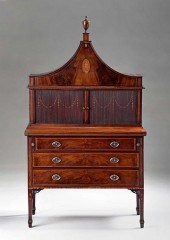 A RARE AND IMPORTANT BOSTON FEDERAL
A RARE AND IMPORTANT BOSTON FEDERAL INLAID MAHOGANY PED...circa 1800, one of only three known, and the only example in private hands, attributed to the shop of John and Thomas Seymour, the three section desk in highly figured mahogany, the pedimented top section with hinged fall front surrounded by an inlaid plinth and urn finial, the tambours finely inlaid with bellflower chains and opening to reveal a blue green fitted interior, fitted with its original baize lined writing surface, the case sides with original brass carrying handles, the lower section with hinged lid with inlaid edge opening to the original blue baize lined writing surface, over three graduated doors each fitted with exceptionally rare original cobalt blue enameled pulls, on inlaid legs with pierced and carved knee returns, 66 x 37-1/2 x 27-1/2 in. Exhibited: Concord Antiquarian Society; The Museum of Fine Arts Boston, 1958-1984 Literature: illustrated in Vernon Stoneman, John and Thomas Seymour Cabinet Makers in Boston 1974-1816 , pages 88 and 89. Note: Only two other examples of this remarkable pedimented tambour desk form are known to survive from Federal America, and to our knowledge this is the only example still in private hands. The first is in the collections of The White House (see attached). The other example descended in the Proctor family and sold at Sotheby's in 1972 and the famous Lansdale Christie's sale, and subsequently to the collection of George and Linda Kaufman. (See Flanigan, American Furniture from the Kaufman Collection , plate 84). Examples without the pediment include a labeled Seymour example at the Winterthur Museum (frontis of Mongomery’s book on Federal Furniture at Winterthur, scan attached). The example offered here is distinguished by its dramatic and rare cobalt blue enameled drawer pulls, which are original to the desk. Extensive research including microscopic finish analysis executed by Susan Buck subsequent to the sale have clarified that the pediment is also from the Seymour shop. Copies of the examination report and the finish analysis results accompany the desk. Condition: accompanied by an extensive condition examination report from Robert Mussey Associates, March, 1998 (attached) as well as microscopic finish analysis by Susan Buck. The knee brackets are replacements, there is warping correction to the fall board on the pediment, finial is replaced and there have been typical scattered veneer patches and repairs and other minor repairs. Mussey notes that in keeping with other works by John and Thomas Seymour, the pediment may have been added 10 to 15 years after the desk was made. He notes that “I have examined approximately eight pieces of furniture, all originally two part secretaries made in the Seymour shop, but which have third sections added on the finished mahogany uppercase tops.... Their construction and details of veneer, inlay and construction are also clearly the product of the Seymour shop.”
A RARE AND IMPORTANT BOSTON FEDERAL
A RARE AND IMPORTANT BOSTON FEDERAL INLAID MAHOGANY PED...circa 1800, one of only three known, and the only example in private hands, attributed to the shop of John and Thomas Seymour, the three section desk in highly figured mahogany, the pedimented top section with hinged fall front surrounded by an inlaid plinth and urn finial, the tambours finely inlaid with bellflower chains and opening to reveal a blue green fitted interior, fitted with its original baize lined writing surface, the case sides with original brass carrying handles, the lower section with hinged lid with inlaid edge opening to the original blue baize lined writing surface, over three graduated doors each fitted with exceptionally rare original cobalt blue enameled pulls, on inlaid legs with pierced and carved knee returns, 66 x 37-1/2 x 27-1/2 in. Exhibited: Concord Antiquarian Society; The Museum of Fine Arts Boston, 1958-1984 Literature: illustrated in Vernon Stoneman, John and Thomas Seymour Cabinet Makers in Boston 1974-1816 , pages 88 and 89. Note: Only two other examples of this remarkable pedimented tambour desk form are known to survive from Federal America, and to our knowledge this is the only example still in private hands. The first is in the collections of The White House (see attached). The other example descended in the Proctor family and sold at Sotheby's in 1972 and the famous Lansdale Christie's sale, and subsequently to the collection of George and Linda Kaufman. (See Flanigan, American Furniture from the Kaufman Collection , plate 84). Examples without the pediment include a labeled Seymour example at the Winterthur Museum (frontis of Mongomery’s book on Federal Furniture at Winterthur, scan attached). The example offered here is distinguished by its dramatic and rare cobalt blue enameled drawer pulls, which are original to the desk. Extensive research including microscopic finish analysis executed by Susan Buck subsequent to the sale have clarified that the pediment is also from the Seymour shop. Copies of the examination report and the finish analysis results accompany the desk. Condition: accompanied by an extensive condition examination report from Robert Mussey Associates, March, 1998 (attached) as well as microscopic finish analysis by Susan Buck. The knee brackets are replacements, there is warping correction to the fall board on the pediment, finial is replaced and there have been typical scattered veneer patches and repairs and other minor repairs. Mussey notes that in keeping with other works by John and Thomas Seymour, the pediment may have been added 10 to 15 years after the desk was made. He notes that “I have examined approximately eight pieces of furniture, all originally two part secretaries made in the Seymour shop, but which have third sections added on the finished mahogany uppercase tops.... Their construction and details of veneer, inlay and construction are also clearly the product of the Seymour shop.” -
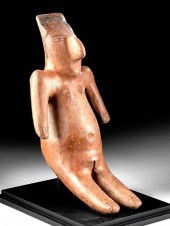 RARE / HUGE NAZCA POLYCHROME
RARE / HUGE NAZCA POLYCHROME SITTING VENUS FIGURE**Originally Listed At $2000** Pre-Columbian, South Coast Peru, Nazca culture, ca. 200 to 600 CE. A stunning ceramic female Venus figure of an exceedingly rare size. The nude figure presents seated upon slender legs with delineated genitalia in-between, a rotund abdomen perhaps indicative of pregnancy, petite breasts, sinuous arms draped from prominent shoulders, and a wide neck. The elongated head exhibits an enormous nose, black eyes with white-painted sclera, a narrow chin beneath a painted mouth, and protruding ovoid ears under the pinched forehead and black coiffure. High burnishing marks provide a textured canvas for the orange-slipped ground, and traces of black, white, red, and yellow pigment add an attractive aesthetic. An extremely rare example of Nazca figurative artistry! Size: 7.3" W x 13.1" H (18.5 cm x 33.3 cm); 14" H (35.6 cm) on included custom stand. A stylistically-similar example of a standing male figure hammered for EUR 11,162 ($12,435.97) at Christie's, Paris "Art Africain, Oceanien et Precolombien" auction (sale 5094, December 8, 2004, lot 340): https://www.christies.com/lotfinder/lot/statuette-nazca-env-300-600-apres-jc-4402593-details.aspx?from=searchresults&intObjectID=4402593&sid=af1d645e-b0ca-4818-abf6-dc7d2b8ab98a Provenance: private Hawaii, USA collection; ex-private Hans Juergen Westermann collection, Germany All items legal to buy/sell under U.S. Statute covering cultural patrimony Code 2600, CHAPTER 14, and are guaranteed to be as described or your money back. A Certificate of Authenticity will accompany all winning bids. PLEASE NOTE: Due to recent increases of shipments being seized by Australian & German customs (even for items with pre-UNESCO provenance), we will no longer ship PLEASE NOTE: Due to recent increases of shipments being seized by Australian & German customs (even for items with pre-UNESCO provenance), we will no longer ship most antiquities and ancient Chinese art to Australia & Germany. For categories of items that are acceptable to ship to Australia or Germany, please contact us directly or work with your local customs brokerage firm. Display stands not described as included/custom in the item description are for photography purposes only and will not be included with the item upon shipping. #148344 Condition: Professionally repaired and restored from multiple pieces, with resurfacing and overpainting along break lines. Minor abrasions to limbs, body, and head, with softening to some finer details, fading to original pigmentation, and light encrustations within some recessed areas. Light earthen deposits and great traces of original pigment throughout.
RARE / HUGE NAZCA POLYCHROME
RARE / HUGE NAZCA POLYCHROME SITTING VENUS FIGURE**Originally Listed At $2000** Pre-Columbian, South Coast Peru, Nazca culture, ca. 200 to 600 CE. A stunning ceramic female Venus figure of an exceedingly rare size. The nude figure presents seated upon slender legs with delineated genitalia in-between, a rotund abdomen perhaps indicative of pregnancy, petite breasts, sinuous arms draped from prominent shoulders, and a wide neck. The elongated head exhibits an enormous nose, black eyes with white-painted sclera, a narrow chin beneath a painted mouth, and protruding ovoid ears under the pinched forehead and black coiffure. High burnishing marks provide a textured canvas for the orange-slipped ground, and traces of black, white, red, and yellow pigment add an attractive aesthetic. An extremely rare example of Nazca figurative artistry! Size: 7.3" W x 13.1" H (18.5 cm x 33.3 cm); 14" H (35.6 cm) on included custom stand. A stylistically-similar example of a standing male figure hammered for EUR 11,162 ($12,435.97) at Christie's, Paris "Art Africain, Oceanien et Precolombien" auction (sale 5094, December 8, 2004, lot 340): https://www.christies.com/lotfinder/lot/statuette-nazca-env-300-600-apres-jc-4402593-details.aspx?from=searchresults&intObjectID=4402593&sid=af1d645e-b0ca-4818-abf6-dc7d2b8ab98a Provenance: private Hawaii, USA collection; ex-private Hans Juergen Westermann collection, Germany All items legal to buy/sell under U.S. Statute covering cultural patrimony Code 2600, CHAPTER 14, and are guaranteed to be as described or your money back. A Certificate of Authenticity will accompany all winning bids. PLEASE NOTE: Due to recent increases of shipments being seized by Australian & German customs (even for items with pre-UNESCO provenance), we will no longer ship PLEASE NOTE: Due to recent increases of shipments being seized by Australian & German customs (even for items with pre-UNESCO provenance), we will no longer ship most antiquities and ancient Chinese art to Australia & Germany. For categories of items that are acceptable to ship to Australia or Germany, please contact us directly or work with your local customs brokerage firm. Display stands not described as included/custom in the item description are for photography purposes only and will not be included with the item upon shipping. #148344 Condition: Professionally repaired and restored from multiple pieces, with resurfacing and overpainting along break lines. Minor abrasions to limbs, body, and head, with softening to some finer details, fading to original pigmentation, and light encrustations within some recessed areas. Light earthen deposits and great traces of original pigment throughout.
...many more examples with full details are available to our members - Learn more

